



As curator of the exhibition Monsters of the machine: Frankenstein in the 21st Century, I thought it necessary to interview the artists in the exhibition, while it is shown in the magnificent gallery space at Laboral, in Spain, until August 31st 2017. I wanted to get more of an idea of how they see their work in the show relates to the core themes. Mary Shelley’s book Frankenstein; or, The Modern Prometheus, has been interpreted in numerous ways since was written in 1816, and then published anonymously in London in 1818.
Eugenio Tisselli is a Mexican artist and programmer. He is a PhD candidate at Z-Node, the Zurich Node of the Planetary Collegium. Previously, he worked as an associate researcher at the Sony Computer Science Lab in Paris and was also a teacher and co-director of the Masters in Digital Arts program at the Pompeu Fabra University in Barcelona. In his role as director of the ojoVoz project, he has carried out extended workshops with small-scale farming communities in different parts of the world. The ojoVoz project may be accessed at http://ojovoz.net. His personal projects may be accessed at http://motorhueso.net
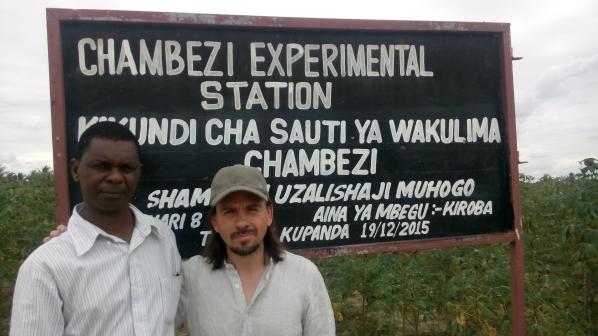
Marc Garrett: Can you explain how and why the Sauti ya wakulima, “The voice of the farmers” project came about?
Eugenio Tisselli: In 2010, I came to realize that the way we feed ourselves is actually one of the main drivers of the accelerated destruction of societies and ecosystems that is currently underway. I felt like I had been living in La-La-Land before the veil was ripped off. My life changed radically. At that time, I was collaborating in the megafone.net project which had worked since 2004 with several groups of people at risk of social exclusion in different parts of the world. By offering an unfiltered communications platform, consisting of mobile and web applications, the megafone project tried to help these groups to make their voices widely heard. But, in 2011, I left the project with the purpose of offering its tools and methodologies to farming communities who wished to seek recognition and explore different forms of communication.

The first opportunity took shape in Bagamoyo, Tanzania, where a group of farmers expressed their interest in trying out these tools. I came in contact with this group through a scientific project that studied the direct and indirect effects of climate change on agriculture. The original goal of ‘Sauti ya wakulima’ was that the farmers would use smartphones and a web application to create a collaborative, audiovisual knowledge base of weather-related events, such as droughts, floods or crop diseases. However, the farmers eventually discovered that they could reshape this goal, and started to use the phones to interview other farmers with the purpose of creating a network of mutual exchange of knowledge about agricultural practices and techniques.
Episodes of fruitful learning have happened since then: one farmer learned the proper way to grow maize thanks to a picture taken by one of his colleagues. Another one learned a clever way to build chicken sheds during a trip to an agricultural fair. He took pictures of the sheds and when he came back to his community, he formed a cooperative for chicken production together with three of his colleagues. I could go on, but the project is still active after six years and that is probably the best thing that can be said of ‘Sauti ya wakulima’. It is alive because farmers find it useful, and it’s inspiring to learn from them that the mutual exchange of knowledge can become a key to a more resilient and interesting life. To me, the agricultures depicted in the photos posted by the Tanzanian farmers are not echoes of ‘the past’, but pathways to the future.
MG: What particular themes in the exhibition do you feel relate to the “The voice of the farmers” installation?
ET: I imagine ‘The monster in the machine’ not as a horrible, threatening ghoul, but as a weird and tricky creature made of language. The ‘body’ of this creature is made up of what we would call ‘principles’, ‘values’ and even ‘ideologies’. And it silently lurks inside the technological artifacts we use every day. The smartphone, for instance, epitomizes the ideal 21st century citizen: a self-sufficient, competitive and efficient individual. And, indeed, the monster that lives inside our smartphones is made of those values: its presence is inscribed in the device’s circuits and from there it casts its spell. What I mean is that technologies are not neutral. They are not empty: they are haunted by whispering ghosts.
If you look at technologies used in agriculture, you will also find a multitude of monsters that softly dictate from the insides of things. Perhaps not by coincidence, genetically modified (GM) seeds speak the same things as mobile phones, only with different words. They tell farmers: “stop sharing seeds with your community, it’s a waste. Become an entrepreneur, there are shitloads of money to be made! Buy me! I’ll make you rich!” The sad thing is that these words are a trap: farmers ultimately become entangled in monetized loops that are beyond their control. Desperation sets in and, in absurdly horrible cases, such as GM cotton farmers in India, suicide becomes the only exit. But there are, indeed, other exits.


It is possible to rewrite the values and ideologies inscribed in technologies, in order to make them speak words that will do less harm. This is one of the key components of Sauti ya wakulima. From the very beginning of the project, the farmers agreed to redefine the smartphones as communal tools for collaborative documentation. They still share them and, when it is someone’s turn to use one, that person knows that she will not be taking pictures and recording sounds with a personal device, but with one that belongs to the group. These dynamics of sharing can create or strengthen reciprocal bonds. Renalda Msaki, a farmer who participates in Sauti ya wakulima, once said that the project had brought the group closer together. When I reflect upon her words, I can see how the monster in the machine can be transformed into a gentler creature that, nevertheless, remains weird and tricky.


MG: What role do you think the artist has when dealing with questions such as Monsters of the Machine exhibition?
ET: I think the artist can take up an incredibly vast range of roles when dealing with machines. But, whatever one does, one shouldn’t be naive about technology. Happily, the times when media artists created huge and complex pieces filled with little technological wonders just because it was exciting to celebrate their ‘magic’ is (almost) over. I used to say that (most) media art was the smiling face of techno-capitalism. Now I would add that, while technology was generally understood as a mediator between us and the world, it has now become a vector that uses humans to create its own mediations with the world. The roles have shifted, and things have taken a perverse turn. There’s a growing chorus of techno-objects that insistently asks us, humans, to drill the Arctic, build pipelines, burn coal, destroy forests and dig up more minerals. And we obey: we must feed the monster. Artists who approach technologies as materials to play with need to be aware of these power relations. We must acknowledge that technologies of all sorts have become overpowering actors that like to command.
Tisselli warns us that we need to be more aware of our responsibilties when implementing technologies into the environment. An important factor of the exhibition was to bring about a vision where the art was not just one type of art. This means different engagements in how we see and work with technology, are reflected as part of its context. Also, technology is not only a human skill, ’21st century scientific studies indicate that other primates and certain dolphin communities have developed simple tools and passed their knowledge to other generations.'[2]
As I write this conclusion, ‘Trump is poised to sign an executive order that will dramatically reduce the role that climate change has in governmental decision-making. The order could impact everything from energy policy to appliance standards.'[3] We live in a time where US policies are written via Twitter, and the rich are typically risking ours and the world’s future for their own ends. Tisselli and the farmers, remind us that, we need to be connecting with the land once more. We need to reclaim the soil before it is lost forever.
Mary Shelley’s distrust of the patriarch in the form of Dr. Victor Frankenstein, is as relevant now as it was 200 years ago. ‘Her portrayal of Dr. Frankenstein as an egocentric obsessive who will stop at nothing until he completes his mission in bringing his creature to life; represents man’s blind quest in pushing on until the precarious end, at whatever cost.'[4] Tisselli echoes this with his own critique towards artists working in technology. If we are to rethink what innovation can be now, what would that look like if we were to update it in a way that included indigenous voices, other levels of equality, and practices beyond what now seems like tired, machismo, and over obsessive, tech-enchantment?
The ‘Monsters of the machine: Frankenstein in the 21st Century’ exhibition is on at at Laboral, in Spain until August 31st 2017. http://www.laboralcentrodearte.org/en/exposiciones/monsters-of-the-machine
Those involved in the Sauti ya wakulima / The voice of the farmers project.
The farmers: Abdallah Jumanne, Mwinyimvua Mohamedi, Fatuma Ngomero, Rehema Maganga, Haeshi Shabani, Renada Msaki, Hamisi Rajabu, Ali Isha Salum, Imani Mlooka, Sina
Rafael.
Group coordinator / extension officer: Mr. Hamza S. Suleyman
Scientific advisors: Dr. Angelika Hilbeck (ETHZ), Dr. Flora Ismail (UDSM)
Programming: Eugenio Tisselli, Lluís Gómez
Translation: Cecilia Leweri
Graphic design: Joana Moll, Eugenio Tisselli
Project by: Eugenio Tisselli, Angelika Hilbeck, Juanita Schläpfer-Miller
Sponsored by The North-South Center, Swiss Federal Institute of Technology – Zürich
With the support of The Department of Botany, University of Dar es Salaam (UDSM)
The Delfina Foundation selected Jean-Paul Kelly to undertake a residency in winter 2015. During his residency, Kelly regularly attended the City of London Magistrate’s court in Central London as a visitor. For eight weeks, he observed the routine events and procedures that took place in the courtroom. The UK’s Criminal Justice Act prohibits any form of documentation within the courtroom, whether it be a sketch or a recording, and only allows illustrators to take notes, most likely in the quick and loose form of stenography.
The absence and overall restriction of documentation within a courtroom (and beyond) leads to the fairly obvious skewing of narrative events. Kelly, who works with found photographs, videos and sounds originating from documentaries, photojournalism and online media streams, realised that the particular restriction was advantageous to the concept and the production of his new work, That Ends That Matter. For him, lack of evidence or documentation of a specific event elucidates a direct relationship between physical materiality and subjective perception of each individual.
Such situations, in which evidence is lacking, fabricate image representations based on a very unreliable form of intangible reflection and recollection as both shared and personal memories. In our day and age, information is as effortlessly accessible as the Evening Standard on the Underground. However, within the courtroom, a place of supposed honesty and acknowledged transparency, the lack of documentation is paradoxical and challenges the sovereignty of such proceedings. That Ends That Matter is an eight-minute, three-channel video acting as a subjective reproduction of the events Kelly witnessed at court. One video re-enacts the court proceedings, another shows a constant photographic image stream as a retelling of the events and the remaining video acts as a visual soundtrack animation made out of geometric shapes.
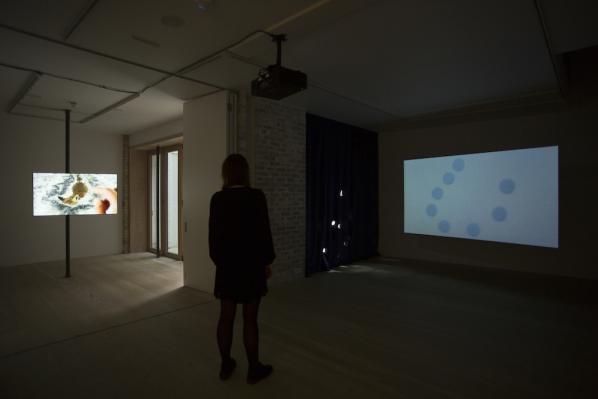
Initially walking underground into Delfina’s bunker exhibition space, the viewer is confronted by the loud noise coming from the visual animation. To the left of the space, two screens are paired together – the image stream with the animation – and to the right of the space, the re-enactment stands alone. Encountering three screens, viewers may feel bewildered as to how to view the work, however, after a bit of floating, it becomes quite apparent that viewing order doesn’t really matter as each visitor finds their own. Some focus solely on the paired screens, others on the lone screen, and some sit against the wall and view the two screens (image stream and re-enactment) of the two spaces from the side together.
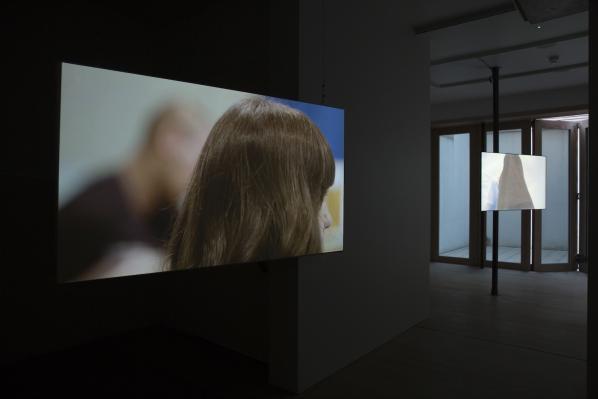
The re-enactment screen video begins, and a soothing female voice sets the tone for the three-channel video:
‘Excuse me, are you appearing before us today? No? Alright, so you’re here as an observer then? Okay, thank you. Welcome… Now we’re going to switch on some noise so we can discuss the matters properly.’
White noise immediately becomes a means of blocking transparent communication, in turn emphasizing the notion of skewing memory and representation of factual information. The re-enactment is played around a table, whereby the actors appear to be waiting around, lingering and passing the time. Although the scene is filled with white noise, none of the participants are talking to each other and there is a particularly eerie focus on an old man who keeps caressing the table with his finger – he soon looks up at us. The environment itself is immersive; the longer the viewer stays with them and observes, the more explicitly the viewer’s presence is felt by the actors. Presence is noticed and through direct and uncomfortable staring at the viewer, it is implied that the viewer’s observation is not wanted. The viewer is thus inclined to move to the left space and look at the other two screens.
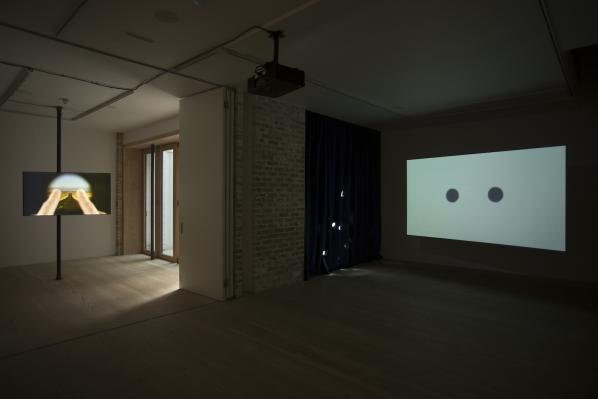
Kelly uses a series of motifs and shapes interacting with the tactility of the artist’s finger or palm in order to establish image representation. When the visual animation screen shows a circle and emits noise, the image-stream presents a finger hiding a specific aspect of the photograph. When it is a square or a rectangle, it is usually a palm that hides a part of the photograph. Tactility in an immovable image stream represents an abstraction towards the idea of transparency. The artist’s hands touch, caress, hide, rub, caress and thus at times become overtly sexual when corresponded with homoerotic images – the hole becomes a motif frequently expended. The motifs of tactility cover people’s faces, acts of violence found in protests, and various scenes of despair. Here, tactility not only acts as a way of forming a temporal moment of surrealism, but also as a method by which one can learn how to connect to the images one sees, much like children touching things for the first time. The white noise itself, from being disturbing becomes soothing and harmonious with all three screens.
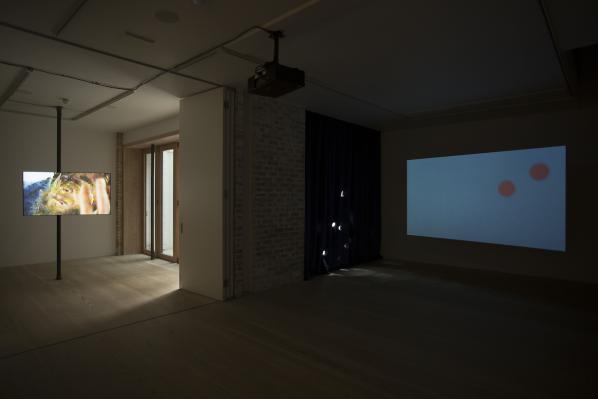
Smoke acts as another motif in images the viewer is shown. In a photograph where protesters are suffocated by teargas, the solution to the pain is pouring milk over your face, another act of blindness. Smoke becomes recurrent, and in the final frames of both the image-stream screen and the re-enactment screen, smoke presents itself with vigour. Smoke appears in the court of the re-enactment screen, and simultaneously, the sound stops altogether as the figures disappear in the haze.

That Ends That Matter’s representational strategy is based solely on memory and subjectivity as its response, much like the creation of human memories. To a certain degree, Kelly’s work embodies apophenia, a way of drawing connections and conclusions from sources that have no direct correlation other than their lasting perceptions – a spontaneous connection. It’s about communicating signs and non-objective matter, behaving in a way that strives to avoid both nostalgia and emotionlessness in order to question indexical notions of ethics in matters of transparency. Kelly may be asking, is abstraction fairer?
All images by Tim Bowditch, courtesy of Delfina Foundation.
“…the futility in this case is underscored by the silly project of bringing forth by mechanical means what nature in any case provides in abundance”1
Visitors to Annette Barbier’s Casualties at Chicago Artists Coalition are confronted by an abundance of dead birds—splayed photographs of birds that nature did not provide any instinct for dealing with gigantic, human-made structures of glass and concrete. Inside these structures are people who have no time to question whether they have any instinct for the same. Barbier’s installation is the intersection of these two sets of animals. Past the short foyer of dead birds, visitors are stopped by a large curtain of feathers without apparent opening. The curtain is lit from behind, flickering. It would be easy to stop here, assuming this giant barrier is the end of the exhibit. In order to progress into the installation, visitors must violate the haptic taboo of the gallery, split the curtain and move forward. Beyond the curtain, the small gallery space is spare. The focus of the installation is an arrangement of kinetic sculptures, sitting on a felt blanket on the ground. Each piece is a rotating wheel of bird feathers, held up by a piece of small gauge PVC pipe. Wires run down the pipe into a single control card. The materials are all apparent but the effect transforms them into minimal bird analogs. With three people in the room, it is easy to see that the feathers rotate faster when approached. With a crowd in the space, the effect is more chaotic and it becomes impossible to discern any relationship between proximity and movement.
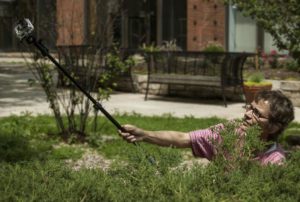
Interactivity inevitably removes focus from anything but the interaction, if it is noticed at all. We saw multiple people investigate the piece, focused only on the electronics, trying to figure out how to “make it go.” In Barbier’s use, this is perhaps an intentional distraction, underscoring the disturbing relationship between humans and undomesticated animals in urban environments. The bird analogs spin pointlessly, pathetically, in relation to our nearness and stand in place of a connection to the natural world. With little time for contemplation and a schedule full of assessment, budget cuts, reorganization and perpetual training, the students, staff and faculty of the University of Illinois (where the majority of Barbier’s photos were taken) only encounter birds as they rain down from their impact against the Brutalist architecture.
The “silly project” described in the Danto quote at the beginning of this review describes Paul Klee’s painting Twittering Machine. Mechanical birds perch above a void, feet wrapped permanently around the wire that controls them. They are joyful and terrifying, tongues of exclamation marks and sharp barbs. One wears a spring while another resembles a fly fishing lure. They are unstable, with questionable guy-wires holding them upright. Their perch is a wave on which they will bobble up and down, and perhaps fall, but only if the handle is turned. Barbier’s birds, like Klee’s machine, are a mere mechanical replacements for living beings, precariously perched and only moving within a severely confined environment.
“In my writing I got so interested in fakes that I finally came up with the concept of fake fakes. For example, in Disneyland there are fake birds worked by electric motors which emit caws and shrieks as you pass by them. Suppose some night all of us sneaked into the park with real birds and substituted them for the artificial ones. Imagine the horror the Disneyland officials would feel when they discovered the cruel hoax. Real birds!”2
Where Danto saw an abundance of nature, Philip K. Dick, quoted above, sees the replacement of wildlife with structured wildlife encounters. The artificial birds flutter and respond to our presence but only represent birds as humans imagine them. Barbier’s fake, electric pinwheel birds reduce the illusion to a mockery. The foyer of the installation shows the results of human architecture, inside we are confronted with the futility of seeking a technological solution.
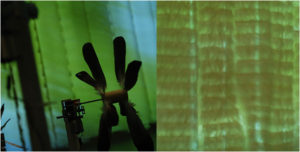
“We are the first generations born into a new and unprecedented age — the age of ecocide. To name it thus is not to presume the outcome, but simply to describe a process which is underway. The ground, the sea, the air, the elemental backdrops to our existence — all these our economics has taken for granted, to be used as a bottomless tip, endlessly able to dilute and disperse the tailings of our extraction, production, consumption.”3
Casualties is not a call to action but a dirge, room silent but for the mechanical sound of small motors. Unfortunately, the human-centered reduction that Barbier’s sculptures outline, a false dichotomy in which we can only “save” or “destroy” nature, is undermined by an associated event. In a catalog insert, we are invited to a workshop on Preventing Bird Strikes. In this two hour workshop, we can learn to “create [our] own DIY devices to help birds avoid collisions with reflective glass surfaces.” The disjunction of human and natural is a much deeper issue and Barbier’s installation poetically makes visible a small intersection in civilization that is incredibly complex, and broken.
_
Images and video courtesy of Annette Barbier
Featured image: still from Fatima Al Qadiri / Sophia Al Maria HOW CAN I RESIST U
E-Vapor-8 is a very cool group show which looks and feels about as much like a club as you would want it to. It features a series of haunted works opening onto the “death of rave” — and what that death means, when it happened, and if it is still happening, are the most interesting questions provoked by a visit.
Works by Fatima Al Qadiri, Daniel Swan, Petra Cortright, Rhys Coren become the characters and rooms of a labrinthine underground culture which takes emotion, history, sexuality and race as its headliners and resident evil. It is a small exhibition, considering this scope, and perhaps not the show which the curators would lead us to believe.
The notion of cultural ‘Afterlife’ enters the fray as surely and convincingly as a sweaty-metallic-render 3D blade drifting though green wireframe. Afterlife is a ziegist topic – Transmediale’s Afterglow theme explored an afterward of an already exploded digital scene; Mark Fisher’s term ‘Hauntology’ connected Derridian theory to underround music/artists like Al Qadiri and Maria Minerva; and the recent New Death exhibition at FACT featured works such as Jon Rafman’s installation, depicting an indecent internet-accelerated-libido as a kind of end-of-the-world-is-now scenario. In these works and perspectives the realm of the afterlife is shown to be a nuanced one from which to view the epochal changes culture has undergone, and this is why a show like E-Vapour-8 feels so timely.
The name of the exhibition is taken from a 1992 rave track, but it also makes me think of the recent rash of e-cigarette shops…

and, more portentiously musical genre coinage I know from reading Adam Harper’s contemporary music commentary: vapourwave –
“At the end of the world there will only be liquid advertisement and gaseous desire. Sublimated from our bodies, our untethered senses will endlessly ride escalators through pristine artificial environments, more and less than human, drugged-up and drugged down, catalysed, consuming and consumed by a relentlessly rich economy of sensory information, valued by the pixel.” Adam Harper in DUMMY

Several of the best works here are available to view online, and benefit greatly from the throb and thurst of this gallery setting. Watching Daniel Swan’s Plane Drift V on a hi-def monitor, I appreciated the use of lo-fi pixilation as part of the affective ether of the work, as the utopian 3D crumbles into a flat and luscious digital irony. The video ends its loop on a frieze of a 3D plaque stating ‘Return’, evoking the role of the loop in dance culture, and the mode of reinvention in evidence throughout the show.
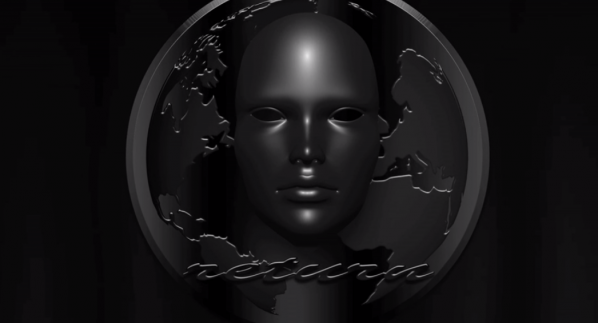
Fatima Al Qadiri’s tune How Can I Resist U with a new video by Sophia Al-Maria dominates the main gallery space with its unsettling deep bass underflows, and audaciously cool bringing together of urban architecture with international dance cultures. In the other room, Petra Cortright’s voyeuristic film Lara Practice shows a young girl trying out her ecstatic dance moves presumably to rewatch later – a tragic pantomiming of ‘happy hardcore’.
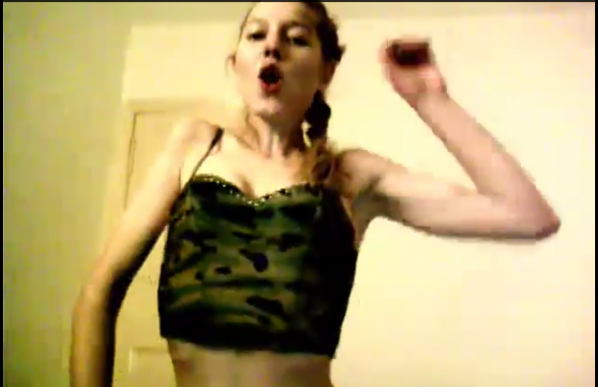
Other works play on the aesthetics of given rave cultures. Travis Smalley’s Wave Trancendence splays the multi-coloured trippy aesthetic of early hardcore flyers as a sickly overlush chill-out visual.
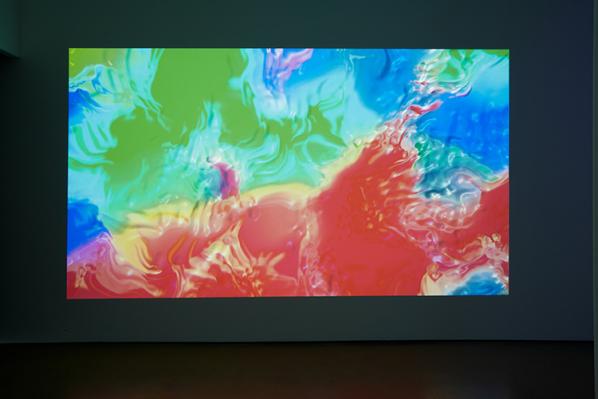
Adham Faramawy’s Lifeproof iPhone Cover revisits the metallic Photoshop filter and puts it in motion, his work simultaneously harking back to late-90s era Drum n’ Bass, while having the look and feel of a vapourwave.jpg – except instead of vapour-wave’s marble, the plinths and stands for Faramawy’s work ooze black foam, like an ashtray left in the alley behind your mum and dad’s for thirty years.
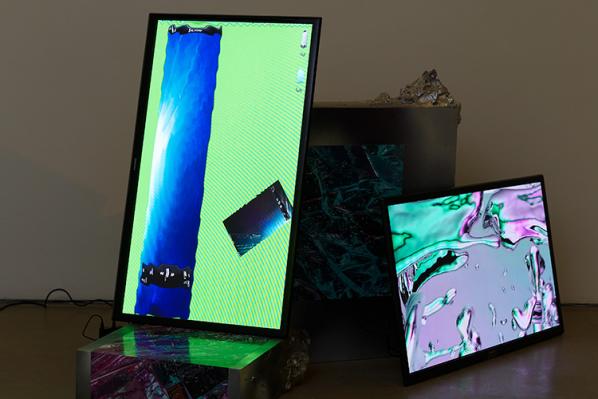
This incongruous collection of perspectives, along with the jostling beats across the whole show provoke a kind of nervy excitement. Installations in the show also play and elide bliss and paranoia. Harry Burden inverse-casts a crumpled car wing and paints it in a pearlised blue and green like a strange beetle.
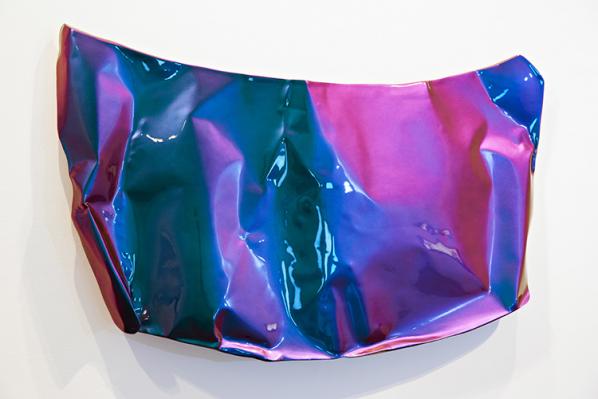
Alexandra Gorczynski’s liquid dream-like video peers up queasily from under a glittery canvas bedcover, and Maria Olsen’s gold tapes in a heap on the floor; each item together and the same, but the artifacts themselves – the music, the person – alone in their capsule.
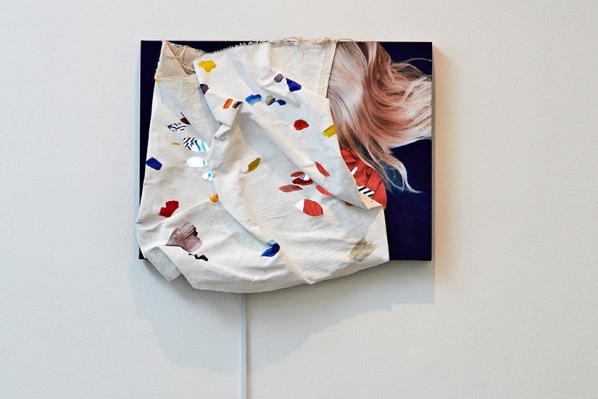
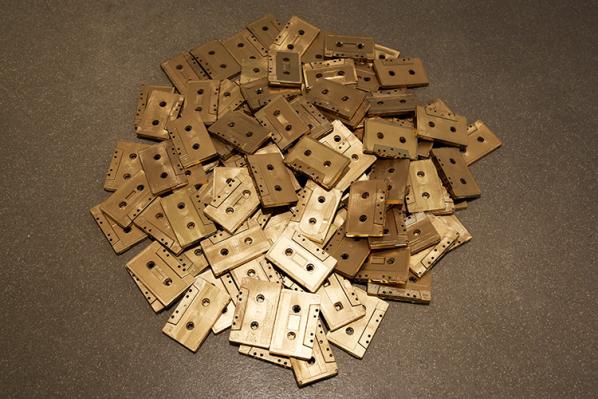
Only Rhys Coren’s playful video-loop doodles set across three screens to a chirpy four-four house beat seem unequivocally ‘happy’ – but we notice that even here, the screens face away from each other, and the animations jiggle on their own buzz.
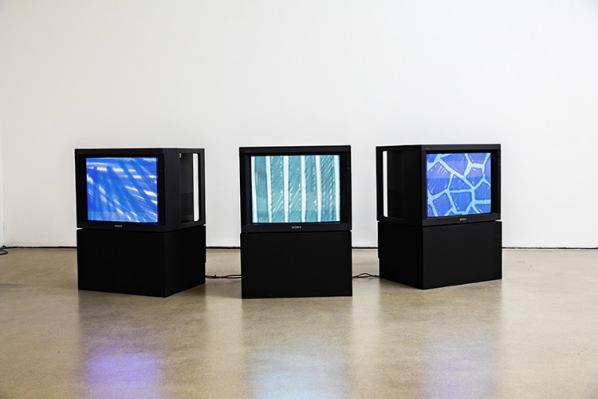
Sitting off in the corridor like a rushed-out raver afterwards, the trouble with this show sinks in. In her short introductory essay, curator Francesca Gavin acknowledges that many of the young artists she features are not old enough to have experienced the first ‘white glove’ rave referenced in the title of the show, but neglects to acknowledge the life of rave and dance culture which these ‘subsequent’ generations find ourselves mourning. To an extent, the use of Acid House here has more to do with marketability than criticality – but to jump right from early 90s rave to the work of an artist like Harry Burden, Adham Faramawy or Fatima Al Qadiri, and to locate the older Jeremy Deller’s smiley-face poster artwork at the ‘fulcrum’ of this show, is to willfully ignore the racial and social complex of the Drum’n’Bass, Techno and Trance which followed (as documented most memorably by Simon Reynolds in his Hardcore Continuum series for The Wire).
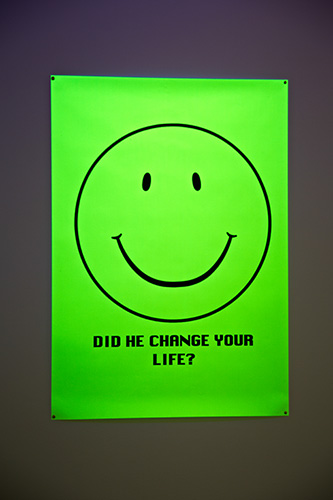
Gavin’s insistance that the exhibition ‘examines the utopian ideas surrounding rave before its failure’, seems to ignore what the artists in the show might consider the actual moment of rave’s failure. This central oversight leads to others. The choice of JG Ballard’s Crash as key-text, while obliquely relevant as an aesthetic touchstone of dystopia, doesn’t really reflect on the ‘realness’ of the scene artworks such as Gorczynski’s reference – it would be nice to have a chance to review the impact of a novel like Irvine Welsh’s Maribou Stalk Nightmares on this generation, or reflect on how current novelists such as Tao Lin use prose style to echo the afterlife of re-illusioned rave and drug culture.
The best works in E-Vapour-8 exist as echoes a UK club culture with more ambiguous relations to capitalism and politics than the radical and resistant Acid House rave. The void left by the hedonistic lifestyle is a simulacrum in a work like Faramawy’s, for the void left in our lives by the death of the hope of capitalism, and our continued afterlife within it – like a club we’re forced to keep revisiting even though it’s too expensive the DJs are shit and people keep getting shot.
The deep cuts in Sophia Al Maria’s and Fatima Al Qadiri’s How Can I Resist U are reconstituted and assimilated into an elegy – to the ‘bootyshake’ and bass, but also to social distribution and emptying out of utopian modernist architectures, using the lo-fi and hi-rise as distinctly modern hallucinations, and touching clearly on Sheffield’s own rave heritage in buildings such as the Park Hill flats.
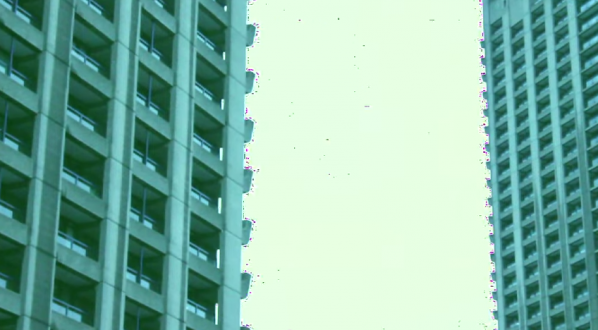
Seen in the light of her generational ‘shortfall’ (being too young to have been seen Altern8 in the Hacienda, but old enough to have got down to Ed Rush at The End) Petra Cortright’s subtle and lyrical cutting and smeering of an original video and its soundtrack in Lara Practice, reminds me of the millenial dancefloor vibe – how out of place those moves were, how re-territorialised they immediately became.
“I start to wonder if she, like me, got sucked in by Ardkore’s explosive euphoria, its manic, fiery-eyed glee, and then got carried along by the music’s logical evolution to wind up at another place altogether, dystopian rather than utopian.” Simon Reynolds ‘”Slipping Into Darkness” The Wire #148
As examples of the thematic depth offered in this show, the Al-Qadiri/Al-Maria and Cortright videos capture the implosion of a naïve energy. By focusing on the female body in the throes of bass, they present distinct and equally valid breakages taking place between anticipation and experience – and the emergence into a darker real and global hyper-real. The artists’ contemporaries in the music scene (including vapourwave artists such as Vektroid and Oneohtrix Point Never) deserve some credit for informing a culture which can act in this way.
It would seem that a gallery of this stature, and a curator with the contemporary culture credentials of Francesca Gavin – visual arts editor at Dazed – would be more keen to link visual art with actual dance culture, rather than a fully assimilated cultural caricature like happy hardcore… but then, the exhibition itself is an opportunity for us to do just that.
I recommend a visit – the show is on until August 17th. Those who were in a circa-1998 nightclub will recognize the nervy and unsettling sensation of the corridor or cloakroom queue, the combination of E-high with screw-face attitude. A steady, percolating dark bass among the hallucinatory imagery and tongue-in-cheek synth refrains. Those who weren’t will undoubtedly find their own touchstones in these independently deeply poignant and distinctly contemporary works.
Play with the Rubik Cube simulator online! Drag the pieces with your mouse to unjumble the puzzle.
Featured image: A live portrait of Tim Berners-Lee (an early warning system). Thomson and Craighead. March 2012.
Flat Earth was published to accompany two solo exhibitions. The first, Not even the sky at MEWO Kunsthalle, Memmingen, Germany from 26 October 2013 – 6 January 2014 and the second Maps DNA and Spam at Dundee Contemporary Arts, Scotland from 18 January – 16 March 2014. The book contains a foreword by Axel Lapp, essays by Dundee Fellow Sarah Cook and DCA Director Clive Gillman as well as an interview with the artists by Steve Rushton.
On the whole, the mainstream art world has failed to ‘convincingly’ adapt to (new) media art and similar contemporary art practices using networks and technology. Thomson & Craighead have overcome this impasse and this is one of a few reasons why they’re so interesting to look at as contemporary artists. The book, Flat Earth does not propose to cover all of their art and this review does not propose to cover all that it is featured in it. The review features Flat Earth Trilogy, The End, October and TRIGGER HAPPY (not in the book).
“Their work provides us with a new perception, through
a completely unexpected multi-focal perspective. They reveal
the wide ramifications of systems of information exchange and
provide us with an insight into the resulting infrastructure of
our own thinking.” [1] (Alex Lapp 2013)
TRIGGER HAPPY: Shooting The Messenger.
Although TRIGGER HAPPY (1998), is not featured in the publication it provides a useful introduction to some of the ideas and conceptual approaches present in Thomson & Craighead’s later artworks. I first experienced the work online, but it’s also a gallery installation that takes the form of an early shoot-em-up arcade game, Space Invaders. This work reflects the sly and cheeky side of Thomson & Craighead and tells us how humorous they can be in their art. TRIGGER HAPPY is philosophical and playful. It asks the player to shoot down the text of Michel Foucault’s essay What Is an Author? published in 1969. [2]
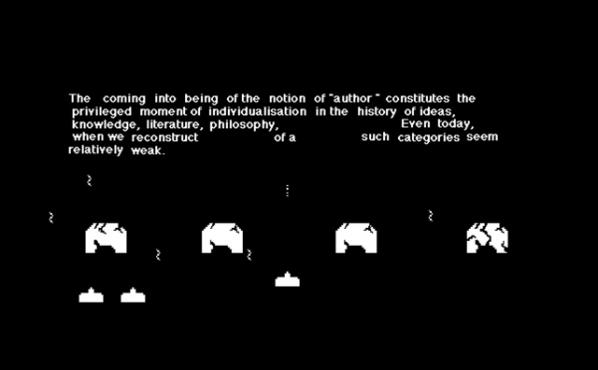
Foucault said the depiction of knowledge is a production and truth is produced, and it is always a reconstructed falsification. In a way TRIGGER HAPPY gives us a chance to shoot at Foucault, who in this respect is the annoying messenger. At gut-level, this art object recognises that on the whole we prefer to shoot at things or play games, than to deal with the complex and pressing questions of our time. Even if the gamer does manage to destroy Foucault’s text, this action prompts an existential enactment of doubt and induces a more vulnerable state of interpassivity. This relates to the illusion of agency when playing games, using corporate online platforms like Facebook and other experiences involving interaction with media, and it can also be extended to life situations. Slavoj Žižek proposes that interpassivity is the opposite of interaction and says “that with interactivity a false activity occurs: ‘you think you are active, while your true position, as it is embodied in the fetish, is passive’. Žižek refers to the Marxist notion of commodity-fetishism to imply that social relations are increasingly reduced to objects (Žižek, 1998).” [3]
We can almost hear the catchphrases “it’s only a movie” or “it’s only a game” as we are compelled to shoot at rather than attend to the messages that may serve to enlighten us and free us from our societal conditioning.
Flat Earth Trilogy: A networked society’s gaze at its mediated self.
The Flat Earth Trilogy is a series of documentary artworks each made entirely from information found on the World Wide Web; with fragments collected from people’s blogs, This covers a six-year period beginning with Flat Earth (2007) A short film about War (2009/2010) and then ends with Belief (2012).
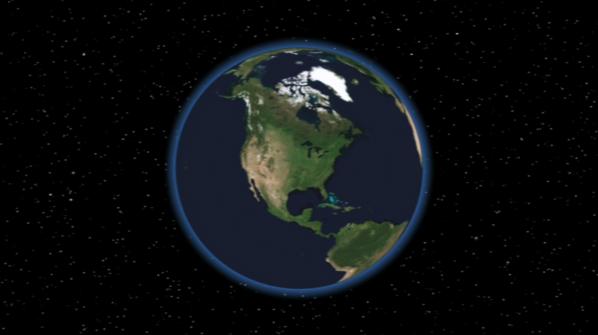
Commenting on A Short Film About War, on their website, Thomson & Craighead write “In ten minutes this two screen gallery installation takes viewers around the world to a variety of war zones as seen through the collective eyes of the online photo sharing community Flickr, and as witnessed by a variety of existing military and civilian bloggers.” [4]
In the book Flat Earth Steve Rushton discusses with Thomson & Craighead why he feels A short film about War works for him best. He says, “It seems to make a claim on truth – which is the traditional claim of the documentary in particular and photography in general – whilst at the same time it shows us that truth is constructed.” [5] (Rushton 2013)
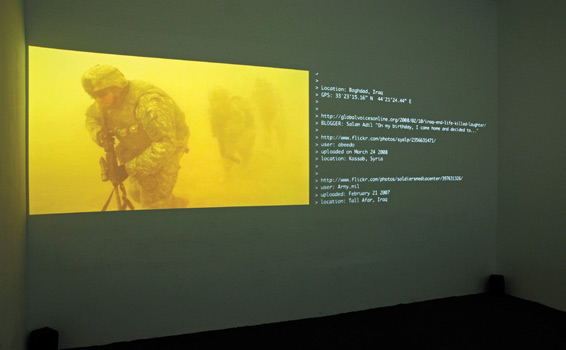
These works challenge our notion of what a documentary is, what and who the author is, and leaves us with the question, what does this mean for the wider society? This brings us back to Foucault’s ideas on the production of truth and its falsification. Tom Snow writes “In the essayistic act of image compilation then, the piecing together of filmic clips and stills distorts the dividing line between fiction and fact, and reimagines the enigmatic relations between photographic mediums and the condition of representation.” [6] (Snow 2009)
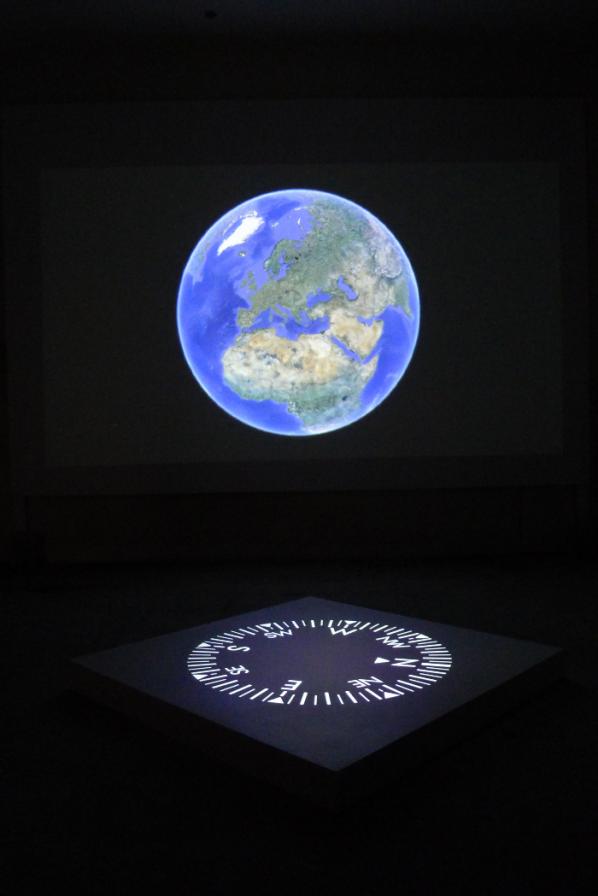
Flat Earth, A short film about War, and Belief all relate to topics concerning human values, conflicts, militarism and everyday societal struggles. “Machines,” wrote Gilles Deleuze in his examination of Foucault’s thought, “are always social before being technical. Or, rather, there is a human technology before which exists before a material technology.” [7] (Berger 2014) And so the technologies we produce are another materialization of the continuing human story.
Millions of people, en-masse, are uploading their personal data (different indications of their states of being) to a collective assemblage. Alex Galloway says that in order to get a better understanding of what networks are we must put aside the idea that networks are a metaphor. He proposes networks as part of a materialized and materializing media. He views this as an important step toward understanding the “power relationships in control societies.” [8] (Galloway 2004)
“It is a set of technical procedures for defining, managing, modulating, and distributing information throughout a flexible yet robust delivery infrastructure.” And “More than that, this infrastructure and set of procedures grows out of U.S. government and military interests in developing high-technology communications capabilities (from ARPA to DARPA to dot-coms).” [9] (Ibid 2004) Galloway’s distinction helps us to re-evaluate what he sees as distracting tropes and uncritical interpretations of the Internet, the World Wide Web and Web 2.0.
Thomson & Craighead provide parallel insights through their artwork into the protocols and technical procedures governing the functions of networks. However, human existence and human experience has a relationship with these networks and, out of millions of interactions, evolves not metaphors but fragmented symbolisms and stories. These are telling us about a networked society’s gaze at its mediated self. And this is where art can play a special role in critiquing, communicating and sharing the nuances of this emerging multitude.
The Flat Earth Trilogy presents us with a complexity where everything is flattened out. It maps out a human psyche from an anthropological perspective. And this leaves society to deal with issues concerning the human condition entwined within a machinic evolution.
This evolution has no physical body even if real lives and bodies are its source material “each mode is displaced by machinic evolution, mixing flows and the shifting codes and overcodes of power, the base forms continue onward, written directly into the heart of the system.” [10] (Berger 2014)

To further understand this work in relation to the machinic evolution, the networked gaze, and human interaction, I feel there is some value in considering hyperreality “…a condition in which what is real and what is fiction are seamlessly blended together so that there is no clear distinction between where one ends and the other begins.” [11] Hyperreality is a post-modern term used by Jean Baudrillard, Albert Borgmann, Daniel J. Boorstin, Neil Postman, and Umberto Eco. However, if we add a contemporary flavour to what hyperreality looks like now in a networked society we come up with hyper-mediality. “What we refer to as reality very often is just mediality, and also because that’s how human nature often prefers to observe reality, you know, via some media.” [12] (Ubermogen 2013)
We can see an example of this condition in an artwork by artists’ Franco and Eva Mattes, with their performance video No Fun (2010) [13] where they staged a suicide in the popular webcam-based chat room Chatroulette.
“Notably, only one out of several thousand people called the police. Moving beyond the aspects of shock and provocation, this touches on a basic question: What does “reality” mean in the digital age?” [14] (Eva & Franco Mattes)
The Flat Earth Trilogy throws up many questions and you’d be forgiven for thinking we need another book to fully examine the ramifications of these artworks. Instead let me to refer you to other related texts by Tom Snow, Edwin Coomasaru, Jo Chard, and Alan Ingram by clicking here http://www.inmg.org.uk/archive/thomson-craighead/catalogue/

Shifting Sands.
Clive Gillman in his essay in Flat Earth says “if artists are to find a way to assert a commentary or expression through these emerging forms of contemporary media, they will have to do this by reconciling the resistance of these new media objects to be ordered into a form that may represent a recognisable notion of artistic intent. And it is into this challenge that Thomson & Craighead pitch themselves.” [15] (Gillman 2013)
It is not the audiences who have difficulties with emerging forms of contemporary media it is the mainstream art world, and this is most of its magazines, galleries and museums. From our own experience of showing art and technology at Furtherfield Gallery, audiences tend to be adventurous and open-minded regarding their experiences with technology and societal issues. And yet the art world has had difficulties making a place for this work.
Sarah Cook and Christiane Paul, both curators well versed in the field of media art, have tirelessly offered us convincing arguments why this is. Christiane Paul says, “Many curators and other practitioners in new media seek to “teleport” the art out of its ghetto and introduce it to a larger public.” [16]
Sarah Cook says “artists who are really working with technology are still redefining art. So they’ll always be “in emergence” [..] They always will try to change the boundaries of what we think Art is and challenge the institutions that show it.” [17] This is true with Thomson & Craighead’s installation and networked artwork. It is plugged directly into a larger, expansive, worldly discourse, in contrast to traditional modes of artistic and news presentation which are highly restrictive and contained within their mediated monocultures.
Gillman proposes that Thomson & Craighead are pitching themselves to create art which is a recognisable notion of artistic intent, and other artists should do this also. I am assuming this is so the work is recognisable as ‘art’ to the mainstream artworld and its traditional remits. This is a strange ask if you are an artist who is truly exploring further than what is typically expected by mainstream art culture. I would argue that artistic context and its values are not fixed and that’s the point. If artists become too self conscious in trying to make their art look like an art that “fits”, it then looses its imaginative edge and critical reasoning.
It’s a difficult balancing act if the artist is examining deep or necessary questions whilst the current art world is lagging behind in so many ways. Julian Stallabrass sees this lagging behind as a political issue. In his book Contemporary Art: A very Short Introduction, he critiques the blocking of emergent, and critically engaged artistic expression as part of a ‘New World Order’ where we are constrained by a compliant culture controlled by the rampant demands of a corporate elite, who only consider art in terms of economics, markets and brands. And these restrictive and dominating frameworks are dedicated to the neoliberal promotion of privatisation and growing inequalities.
In his article ‘Reasons to Hate Thomson & Craighead’ he says “At this point, the art professional sees a world crumbling, visions of empty galleries, unique works owned by everyone, a stuttering and then failing of artspeak amid a mass proliferation of ‘work’ and comment, the autonomy of art ruptured, artists and dealers redundant, in short an economy broken and the sacred polluted with the profane. Naturally, representatives of the old order, more or less sharply aware of dark clouds gathering at their horizons, have good reason to hate Thomson & Craighead.” [18] (Stallabrass 2005)

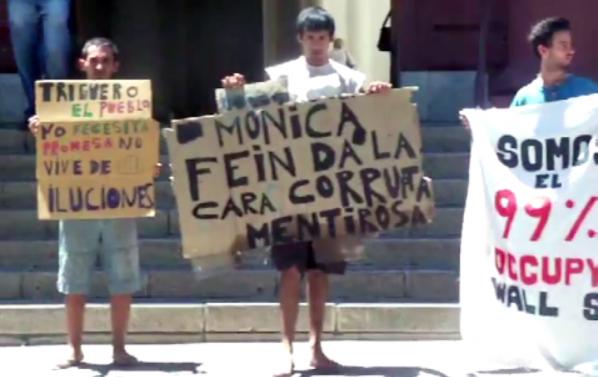
Thomson & Craighead’s work connects with people and they know this because they use content and themes people are thinking about in their everyday lives. This is what makes the series of documentary artworks so powerful. It assembles what is going on in the world in ways that traditional documentary and news channels are not. And this is their real challenge, because if they continue to reflect human culture as it happens with works like October – a documentary artwork about the early rise and fall of the Occupy movement – they will be highlighting messages from a world of people in need of something different than what is currently in place, whether this is deliberate or not. This art has a strange irony, it not only asks us what a documentary is, but it also asks what is news?
The End.

The End is a site-specific artwork first shown at the Highland Institute of Contemporary Art in 2010, Scotland. It is situated in one of the gallery rooms at H.I.C.A that has a large, wall-sized window looking out onto the countryside in the Highlands. It is an intervention into the space where the words ‘The End’ are fixed onto the glass in a style and scale one might associate with the end credits of a movie.
The combination of the outside natural environment, the galley building with its large glass window, and the added text, are assembled together to build a whole artwork. If any these components were taken out of the assemblage it wouldn’t work. This tells us how well crafted Thomson and Craighead’s work is and how much attention is paid to detail.
When looking at The End, one cannot help feeling a little out of sync. It is like a monument or an obituary for a lost world or lost time when we were all standing on solid ground and felt we knew what was real and not real. The End brings into play the rhythms of a larger natural environment and works as a bridge between two worlds or the illusion of it. It reminds us we are no longer experiencing the world face on or directly, but the world is re-introduced to us mainly through screens, televisions, mobile phones and our computers. It also invites us to imagine as we look out on the beauty of the natural world that we are viewing the end of our own role in the story of humanity.
The Situationist, Guy Debord said that people’s alienation was once about having things and claiming better working conditions, but then it moved onto being about a state of appearing. Meaning, it is not producing things, or even owning things that drives society but rather how things appear and how they make us appear. The glass acts as a filter and an interface, a place of safety distant from the touch of the wild. Its physicality, metaphors and symbolism offers a poetic moment for us to consider how perceptions about ourselves and ideas concerning real-life have changed, and what this means.
On the DCA website as part of its commentary about the book, it says Flat Earth presents Thomson & Craighead as pioneers in the field of new media for nearly twenty years. Sarah Cook and Christiane Paul also deserve credit as pioneers for recognising, supporting and dedicating their lives to creating the contexts in contemporary art culture for Thomson & Craighead’s work and other artists’ works. Also, Cook has edited a fine publication. Flat Earth is well designed and the whole book is meticulously well put together with quality images throughout. The mix of inteviews and essays with Thomson & Craighead give the reader a well balanced overview of their the art and their ideas, it is unpretentious and explores their focus as creative and thinking individuals artistically, conceptually and critically. We need many more of these types of books to support this dynamic and ever-changing field.
Thomson & Craighead dig deep into the algorithmic phenomena of our networked society; its conditions and protocols (architecture of the Internet) and the non-ending terror of the spectacle as a mediated life. When reading the Flat Earth publication, you get a clear impression of their conceptual rigour. They know their place and role as artists in society and this is well presented in the book. Their collaborative journey has remained faithful to the World Wide Web, and the Internet as a focal point and a content provider for their art practice.
It would be simplistic to assume they are embracing technology as a celebration of its progress. Their critical scope examines big issues and this is evident in Flat Earth. They belong to a generation of artists who are experimenting with real time data, networks, web cams, movies, images, sound and text; as part of an anthropological venture that studies humanity’s relationship with technology, alongside the inane and profound nature(s) of the human and non-human condition. We exist at a point where ubiquitous computing now redefines our point of presence, shifting our perceptions in reference to cultural tags and repeated experiences of mediation. They successfully critique these changes. Not only to other artists, curators and galleries, but to all who are being transformed by technology and this is what makes them essential and contemporary.
Thomson & Craighead are not just making and showing art they are also presenting questions. These are not invented questions they are already out there. But, just like some need an interpreter to translate different dialogues they are assembling for us the dialogues of an emergent multitude.
Eva Kekou met Tobias Rosenberger at the international e-MobiLArt workshop which took place in Athens, Vienna and Rovaniemi, in turn these led to a number of exhibitions and successful collaborations between artists and theorists. She now invites him to discuss his work, issues of surveillance and how a young European artist views the situation in China and what he expects from his interaction with the Chinese art scene.
Tobias Rosenberger (b. 1980) is a German media artist who works at the crossroads of media art, visual arts, and performance. He has produced art works in Yemen, Spain, Mexico, India, and Ukraine etc. Since 2011 he has been based in China, where he teaches at the College of New Media Art, Shanghai Institute of Visual Art.
“Nowadays, anyone who wants to combat lies and ignorance and to write the truth must overcome at least five difficulties. He must have the courage to write the truth when it is suppressed everywhere; the wisdom to recognize it, although it is concealed everywhere; the skill to use it as a weapon; the judgment to choose those in whose hands it will be effective; and the cunning to spread the truth among such people.” (Bertolt Brecht)
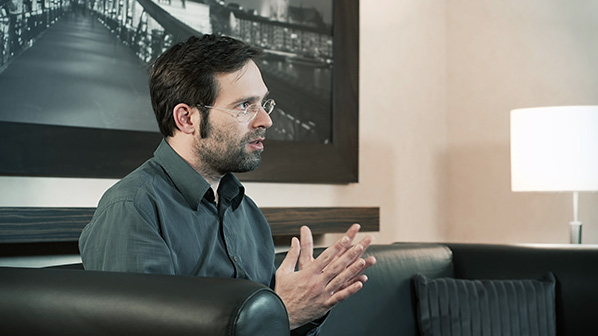
Eva Kekou: I would like to start this interview with this quote which seems to be significant for your work and in particular the recent one – the secret race film and discussion at Goethe Institut Washington. As you well state in your event invite: “It was pure coincidence that for a few days in the summer of 2013, two unrelated events simultaneously dominated the major headlines in the German press: the monitoring and spying scandal of 2013, triggered by Edward Snowden’s leaks of National Security Agency top-secret classified documents, and the official acknowledgement of the prevalence of doping in competitive sports, best symbolized by Lance Armstrong’s televised confession.” What is the significance of surveillance in a globalized social and political context and where is the place of art within it? There are obvious reasons you decided to launch this in Washington through Goethe but I would like you to comment on this.
Tobias Rosenberger: Surveillance and espionage are as old as civilization. Power was always constructed, maintained, and expanded through monitoring, categorising, repressing, and excluding people. We all know that the digital apparatus opens a new world of possibilities to organize, quantify and control life and society in a before unknown scale, speed and efficiency. While I agree that we need early warning models to anticipate and fight cruelty and injustice whenever possible, I don’t believe that we can draw a sharp border between an evil surveillance that fuels unfair and inhuman systems and a necessary one that pretends to save dignity and a lawful order. The challenges of our time can no longer be met by elitism and secretiveness, but require the joint efforts from the middle of society. An independent art that rejects the simple desire for (self-)confirmation does not only open a non-biased discursive space for critical reflection, but it also has the potential to demask and break the mechanisms of power, as long as it takes its audience seriously. But to be able to do so, art also has to find its audience.
EK: It occurs to me that place and space play a very important role in your work and inspiration. How do these relate with each other with pieces of your work in a globalized and mobile network underlined by politics?
TR: I have a very pragmatic approach to what I am trying to do: Not following a specific agenda and always staying as curious and open as possible. This requires both a certain naivety and an observing attitude. I never start an artistic process with a specific idea or question, but i get attracted by places and spaces that i try to discover without too much of my personal baggage. But since space and place are never abstract but segmented by politics both on macro and micro layers, the resulting works often deal with political questions.
EK: How did you become interested in China and what do you find fascinating or difficult working there? Is it interesting for you as a European?
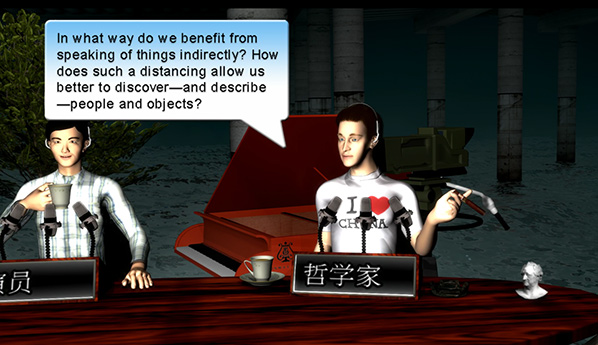
TR: I have a very special relationship to China. With my Chinese wife I decided three years ago to move there and to found a family. I was always fascinated by China as a cultural space, with a tradition of art and philosophy at least as long as in Europe. I also really like the food and the people there. As a foreigner I experience it as very fruitful to see things from a specific distance, both if I try to understand the culture, but also especially if I look back from there to where I come from. It is very interesting to observe the relation between art and politics, how the government here really appreciates art and how it is also afraid of it.

How artists, critics and curators fight for free space, a career, or both. In Shanghai you have both the global economy and the local life at your house-door. The country faces a lot of problems, and very often one can get the impression that things are not happening at all just because there is a small possibility that something unexpected could happen. So many people behave very pro-actively in a way that they won’t run into any problems themselves. But this maxim “to have everything running smooth” you certainly don’t only encounter in China.
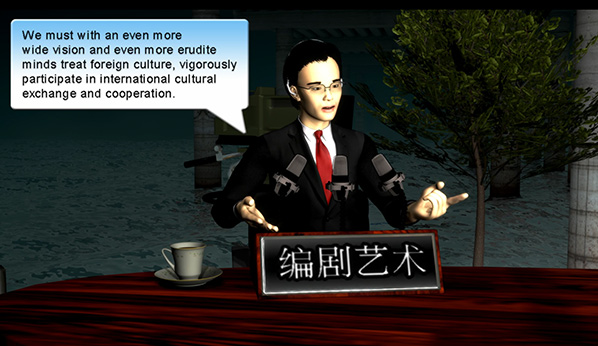
EK: Referring to some of your recent works (installation and performance): Choose any you like… How do you reach out to audiences and what is the main aim in your own work?
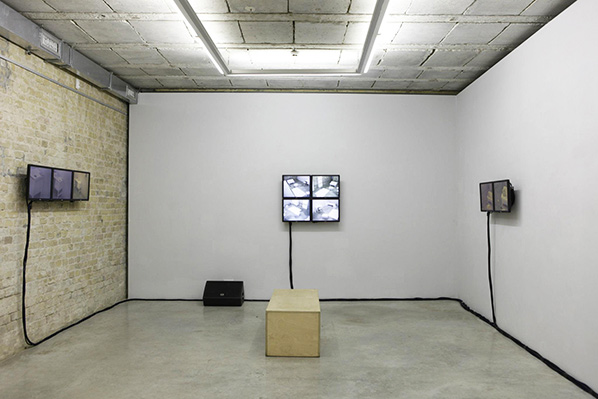
TR: “The First Twenty Years” is an installation that was shown in two different versions at the end of 2012 in Kiev and Dnipropetrovsk. I developed the basic idea for that work in 2011, when I was invited to spend some time in a small Ukrainian village near Kiev at a private artist residency programme. During that time the nation celebrated the 20th anniversary of its independence. There was a strange, partly paralyzed mood. But I also witnessed very controversial discussions with artists, curators and critics, and a new generation that seemed not anymore willing to accept living in a nation that was more and more perceived as a prison. So when I was approached during that time to do a work based on my experiences in the Ukraine, I decided to base it on Xavier de Maistres “Journey around my room” and Schuberts Music, which was inspired by a poem by Christian Friedrich Daniel Schubart.
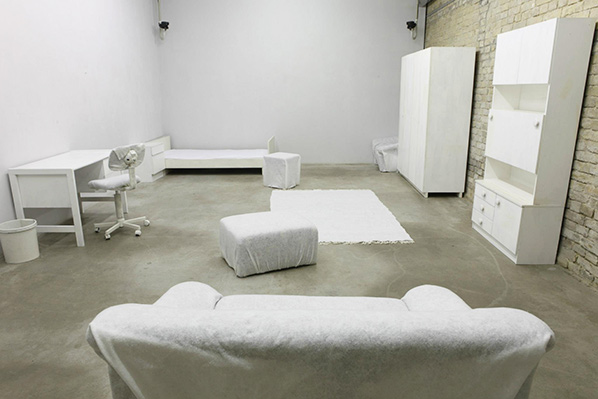
I didn’t intent to comment directly on the situation there, but rather was trying to understand for myself what was happening. For me, art is not about expression but about the creation of a space where everybody is invited to take a bit of distance so to be able discover something from different perspectives and to think in his/her own way.
Surveillance Cameras dancing to Schubert, on Vimeo
EK: Can you give us a bit more information about a project that you have described alsewhere in the following way: “Right now working on a light sculpture for permanent setup in a former WWII Top secret military site, where some crazy NS-Germany scientist wanted to invent an x-ray wonder-weapon to shoot planes and soldiers, this involves an always transforming multichannel-sound installation, motorized miniatures (arduino-controlled), 2 projectors and led-objects. I will make an extra independent video of this work, filmed with multiple moving surveillance cams.”?
TR: I was approached by a cultural initiative that runs today a small history museum in a former research bunker, which was secretly constructed in 1942 / 1943 underneath a camouflage building. I came across a letter in which a certain Professor, Dr. Ernst Schiebold, proposed “An additional weapon to fight and eliminate the crews of hostile airplanes and ground troops in the defensive via x-ray and electron radiation”.
A weird ten pages male war fantasy about a new kind of tubular x-ray canon, written in a crude mixture of physical pseudo-science, soft patriotic enthusiasm and German pedantism. Schiebold really got his bunker built to start with his research. Everything was kept top secret, but stopped 18 months later without results. I decided to bring Schiebold’s proposal back into the space which only existed because of it: As a pure proposal, enhanced and communicated with new media technology.
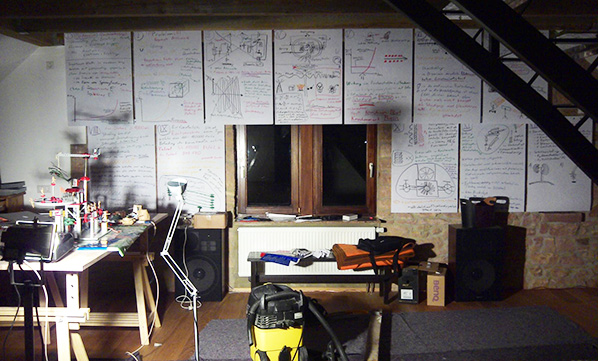
A lot of the tools that we are using as new media artists exist mainly through military development. So my intention was also to give something back. The audience will listen to single sentences that are randomly taken out of Schiebold’s letter and re-arranged into a constantly transforming synthetic sound atmosphere, which is synchronized with light beams crossing a motorized miniature military model. The toy miniatures cast shadows of moving soldiers and airplanes onto the walls. LED lights are flashing out of a tubular manhole, which was originally constructed to be used with a Betatron. All the technology that I use is quite low-budget and geeky. Last week I started to install the parts on site, and I have to admit that it is also a very weird experience for me to spend nights working alone in a former military research bunker, climbing down in a manhole and setting up the mockup of a “super-weapon” people researched in the darkest years of German history. Sure I will also try to document it properly.
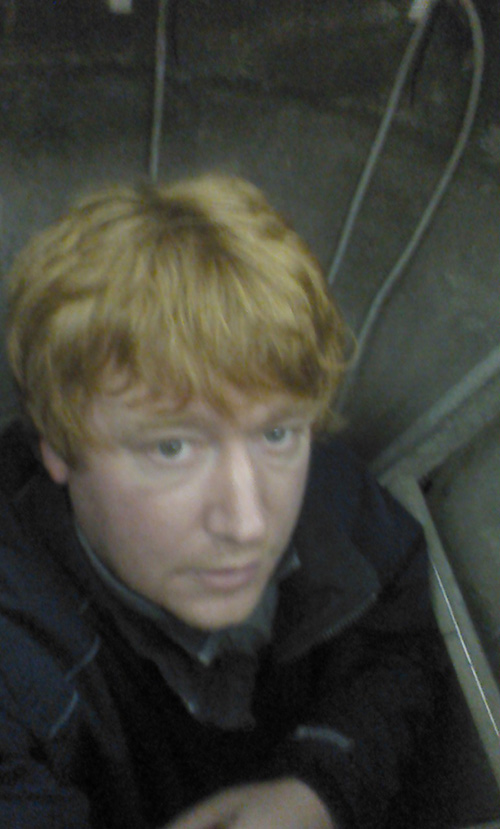
EK: Do you think art can be global and political, if not, what are the main restrictions we are all subjected to? How can art and artists make a difference in this respect?
TR: I think that art is per se political, since it deals with and also influences our perception of reality. And while all our lives are clearly connected in a global economy of good and information-exchange, art does also always operate on a global scale. As an artist I believe that it is worth to be curious and to investigate the (media) apparatuses and dispositifs that surround us, to take them apart and re-design them. What are they good for, what effects do they cause? While the world is getting closer, the world is never the same – people have different histories, problems, possibilities and hopes. As Europeans we take many things for granted, that other people see differently – or vice versa. I think artists can always make a difference, as long as they stay independent and continue to tackle serious questions, but don’t take themselves too seriously while doing so. We should laugh more together.
EK: What are your future aims and plans?
TR: I am looking forward to the new semester in Shanghai, where I will mentor the graduate works of eight students. I will also collaborate with Chinese artist Mujin (Lixin Bao) – a fellow teacher at the Shanghai Institute of Visual Art – on a series of works exploring the notion of the “Chinese Dream” and its perception both nationally and globally. I guess this dialogue will become quite interesting.
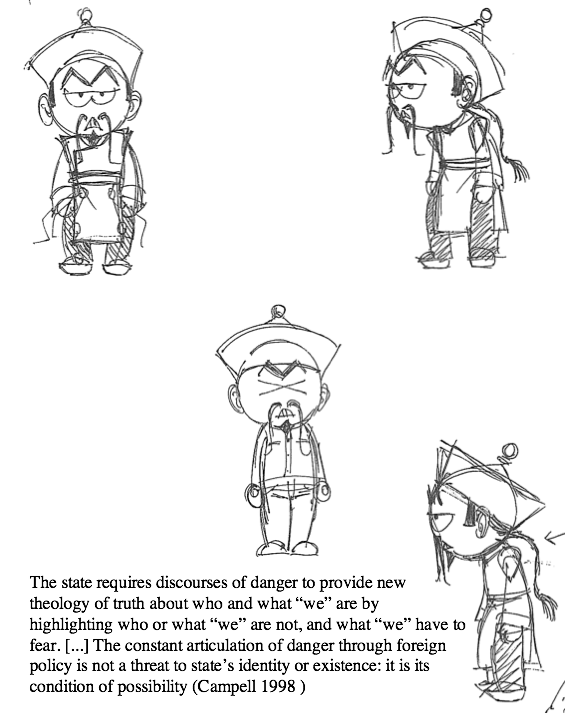
THE CRYSTAL WORLD
The White Building, London
3 August – 30 August 2012
The Space’s White Building cultural centre is within walking distance of the 2012 Olympic stadium in post-industrial, post-regeneration London. As I walked down the steps that lead to it I saw a diesel locomotive pulling a train of cargo containers across an old railway bridge over the canal nearby. Millions of these rational forms will be in transit around the world at any given moment, arranged in two or three dimensions like crystalised capital on trains and docks and ships.
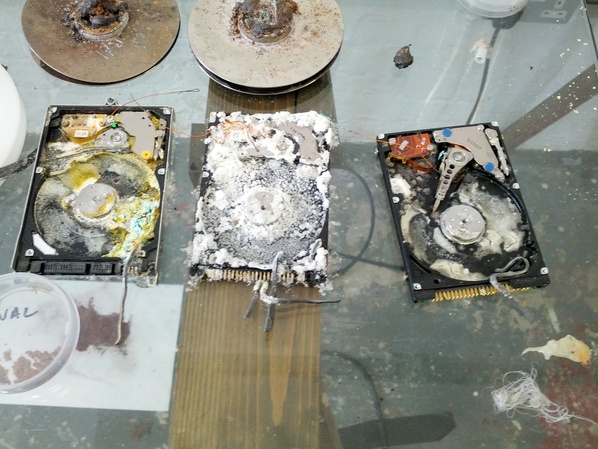
The logistics of their production and distribution are determined by computing machinery using algorithms that operate with inhuman speed and complexity. This same economic logic warps the architecture of the area around The White Building, with old factories and warehouses retro-fitted as office space and as gallery space.
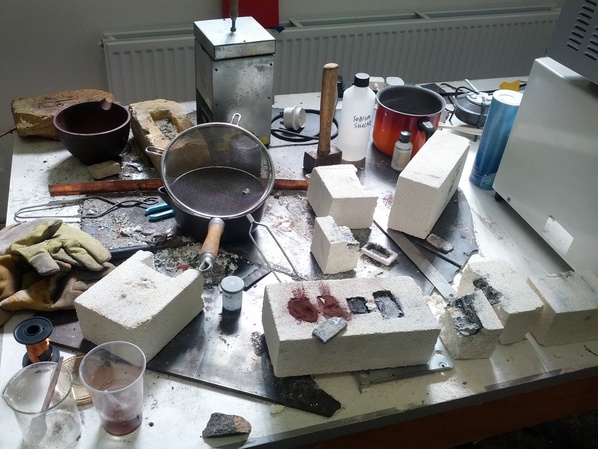
Inside the White Building’s project space the computational enabling technology of the global economy is the subject of a show by Martin Howse, Ryan Jordan and Jonathan Kemp. It takes the title of J. G. Ballard’s novel “The Crystal World” as its starting point. In Ballard’s novel a virus progressively turns all life – vegetable, animal and human – into crystal forms frozen in time. It is a Cold War allegory of the catastrophic imposition of rigid order.
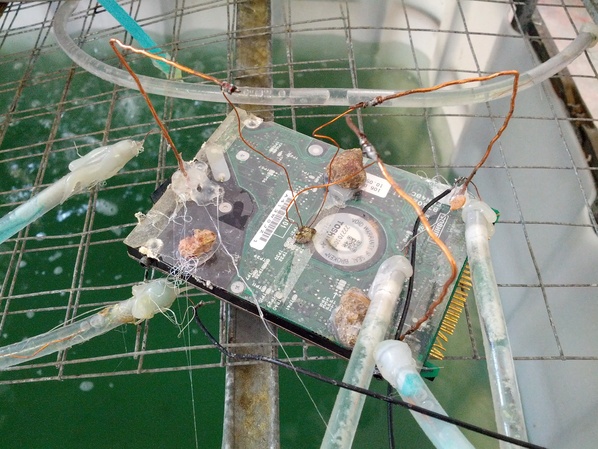
For Howse, Jordan and Kemp these imaginary crystals become the very real minerals refined in the production of the computing machinery used to structure our contemporary world. Inside every digital computer are wires, circuit boards, integrated circuits and other components. They are made from iron, copper, phosphorous, boron, tantalum and other rare earth elements. The central processing unit of a computer keeps time using a quartz crystal. The products of deep geological time are suddenly unearthed and set to pulsating millions of times a second.
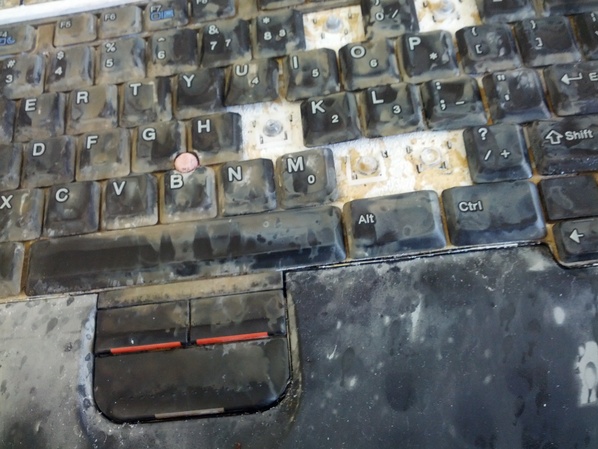
Computers are crystal engines. They are mineral fetishes that we use to manipulate powerful unseen forces that we believe we have mastered, like crystal healers working with a patient’s energy grid. But they are so invisibly familiar to us as our smartphones and laptops and their use in logistics and media is so pervasive that it takes an effort for us to perceive their operation or their implications.
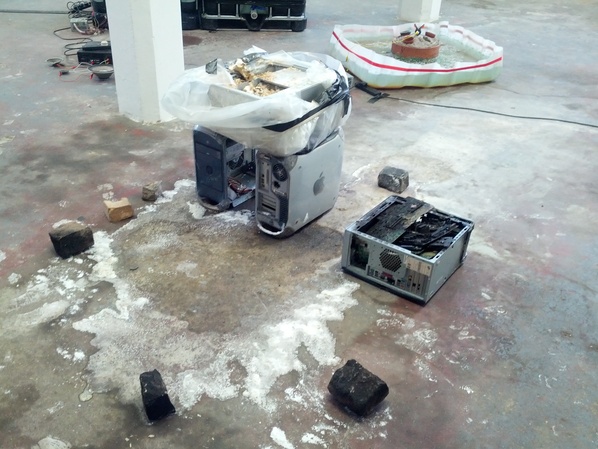
It takes almost two tonnes of raw materials to make a desktop PC. Unlike “Tantalum Memorial” (2008), by Harwood, Wright and Yokokoji, “The Crystal World” focuses on these raw materials geologically and temporally rather than geopolitically. But computing waste is toxic and valuable. The former makes disposing of old computers a growing problem, the latter makes recycling old computers a growing business. The minerals that computers contain can be recycled where they are valuable enough, or left to leach into the water supply in e-waste dumps where they are not.
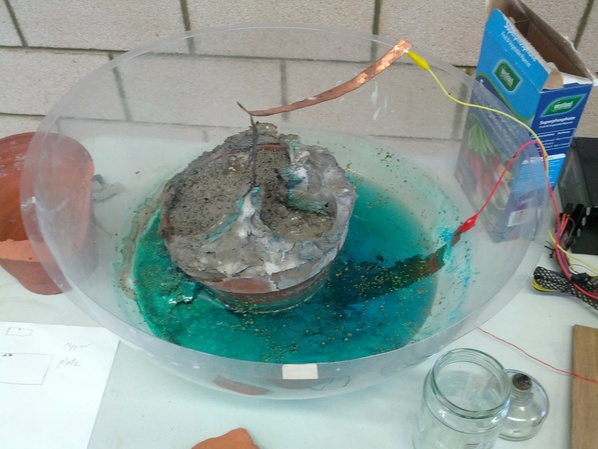
Or in the case of “The Crystal World” an open laboratory and the resultant art installation can re-extract them from their components and printed circuit boards using acid, water, electricity and heat in order to re-crystalise them and return them to geological time. The gleaming silent boxes that organize and mediate our lives are returned if not to the earth from whence they came then at least to their raw materials.
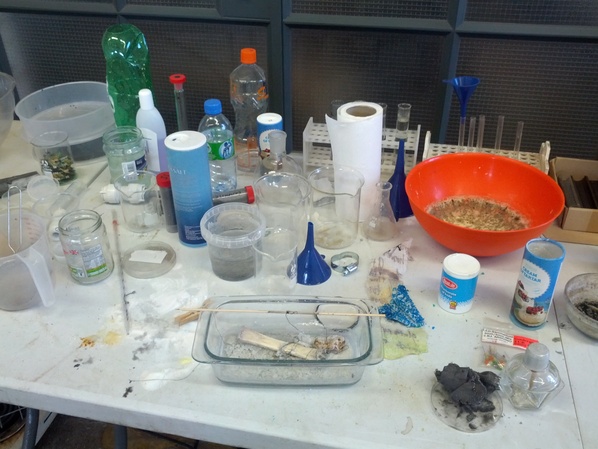
Tables edge the White Building project space, covered with the equipment and results of five days of workshops (and one with books, including Ballard’s, giving any spectators unsure of what is happening a conceptual framework to proceed from). Table after table of crystals, circuit boards, jars, electical equipment, and wires are overwhelming in the details of their appearance and implication. These traces of human activity and inquiry frame the flow of water and electricity in the center of the space, convincing the viewer of the creative intent of its production and drawing them in to its logical universe.
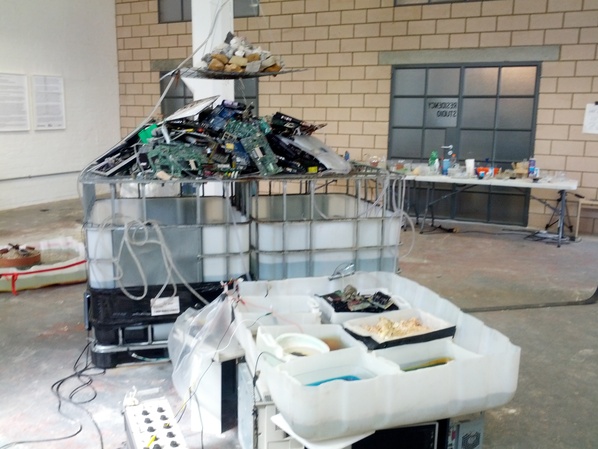
The centre piece of the show is a favela chic water feature that drips acid-loaded water through calcinous rock fragments, over e-waste, into two cut plastic-drum tanks. Next to it an array of smaller plastic containers contain circtuit boards having their copper leeched from them by acid, fungus growing on the by-prodcucts of the project, and other watery deconstructions of computing machinery. It looks dangerous and uncertain, deconstructing both the physicality and the meaning of computers. Seeing the innards of an IBM ThinkPad computer becoming encrusted with calcium like a digital stalagtite, or CPUs branching feathery crystals, returns computing machinery to its raw mineral state. FLOPS give way to eons once more. Neither is a human timescale, yet we must live between them at the moment.

The most fantastical artifact along the walls of the project space is the “Earth Computer”. It’s a battery-like construct of recycled copper and zinc in a tray of silver nitrate attached to lightning conductor-style copper strips. Sitting in earth on a plastic sheet and surrounded by the left-over materials of its creation for the duration of the show, it will be buried nearby afterward. Such a device can function effectively, but not literally. It is more likely to spring to life in the mind of the viewer than if it is struck by lightning. It is effective art, psychic engineering rather than technological cargo culting.
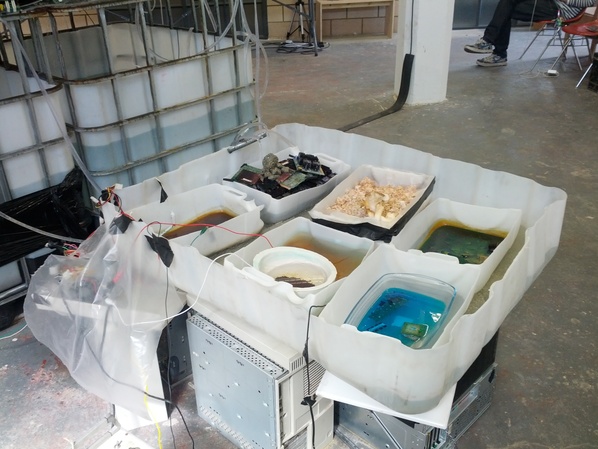
Acid, water and electricity mixed together with e-waste look and feel dangerous. The recycled ad-hoc materials and equipment containing and channeling them reinforce this feel and leaven it with an aura of creative investigation. The form of the show is timeless, the workshop of the alchemist, outsider scientist, or mad inventor. Its content is very contemporary, from Ballard’s rising cultural stock and the social and environmental costs of e-waste to Long Now deep time and posthuman philosophy. Art symbolically resolves the gaps between ideology and reality, and computing is so pervasive and key to society that most people don’t even regard it as ideological never mind conceptualise its failings as such.
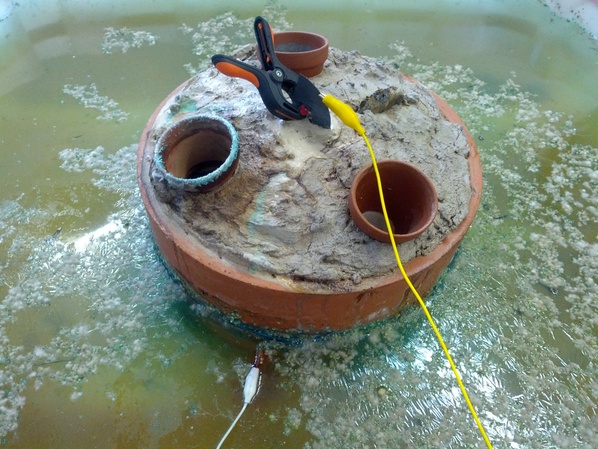
The water and abandoned human artefacts of some of the installations is more “Drowned World” than “Crystal World”, and the broken machinery is more “Crash”. Ballard’s catastrophes provide a modern mythology that is a more useful resource for art than its literary roots might suggest. It achieves the defamiliarising and critical impact of hauntological art without requiring its supernaturalism or nostalgia. There is a Ballardian attitude at play here.
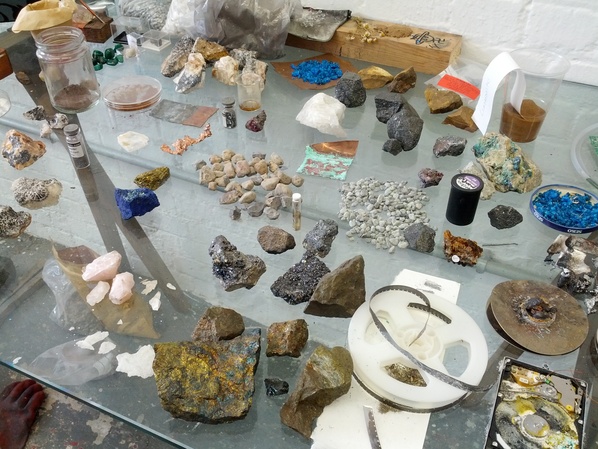
I found “The Crystal World” mind-blowing. It relates the tools of our human existence to non-human substances and timescales, providing the kind of corrective to anthropocentric vanity that object-oriented philosophy aspires to. It achieves this profound insight and presents it in an accessible way precisely because of the modesty of its materials and aesthetics, and because of the resonances of the cultural materials chosen as its starting point.
http://spacestudios.org.uk/whats-on/events/the-crystal-world-open-laboratory-exhibition-
The text of this review is licenced under the Creative Commons BY-SA 3.0 Licence.
Contact: info@furtherfield.org
Part of Furtherfield Open Spots programme.
Seeking to investigate new modes of audience experience, {crowdsourced} Noir / Love Beyond Recognition is a process-based artwork encompassing a sculptural installation and an interactive stream across the World Wide Web. Both parts of the project are based on the notion of “crowdsourcing” and the use of public domain archives for works of art. The physical installation will be exhibited at Konstepidemin Gallery, Gothenburg (SE), with live interactive streams at Furtherfield Gallery, London.
Visitors will be able to search for keywords from a database of short clips selected from the online public domain Film Noir Archive and hear them play through sourced short clips dialogues containing those words, while a live video stream connecting the two venues in London and Gothenburg will show the sculptural installation intercut by those dialogues and related video footage. A compelling cinematic experience is created. Visitors at Konstepidemin Gallery will be also able to see the live stream and hear the dialogues selected by the London-based audiences.
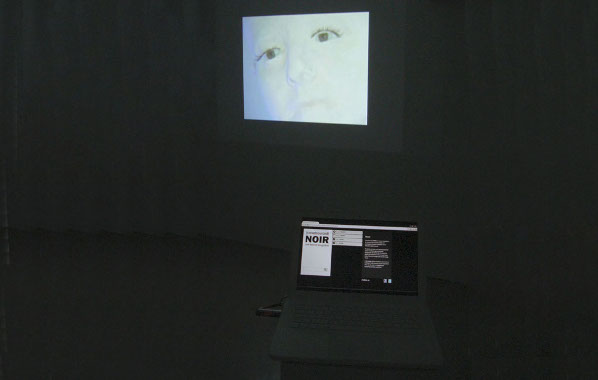
{crowdsourced} Noir / Love Beyond Recognition is a process-based artwork encompassing a sculptural installation and an interactive stream across the World Wide Web. The origin of both parts of the project is based upon the notion of ‘crowdsourcing’. The principle being that more heads are better than one. By canvassing a large crowd of people for ideas, skills, or participation, the quality of content and idea generation will be superior. In this instance, crowdsourcing will be applied through the use of clipsourcing tools which have been developed to aid in project-related tasks that can only be achieved through human interaction/intervention. This way, the crowd will help the artist achieve these tasks whilst adding a democratic element to the final outcome of the project.
During Spring and Summer 2012, an interested public was invited to both participate and contribute to the project’s creative process in two distinct ways: in Sweden as models, whereby a cast was taken of a chosen body part (the body parts were later assembled to full figure sculptures) and in the UK by taking part in a workshop at Furtherfield Gallery to help source short clips from the online public domain Film Noir Archive through our online tool.
The digital part of Posch’s project was developed in collaboration with UK artist and new media developer Mike Blackman.
Josefina Posch
Josefina Posch is a Swedish artist that has worked and exhibited extensively abroad, including at the 52nd Venice Biennale, Fondazione Pistoletto’s Cittadellarte, Sculpturespace NY and a residency at Duolun Museum of Modern Art Shanghai. During her 3 month residency at Art Space, Portsmouth, in Autumn 2010, she began her collaboration with artist and new media developer Mike Blackman in the development of her digital concepts.
The project is supported by Gothenburg City Arts Council, Arts Council England/British Council and IASPIS – The Swedish Arts Grants Committee’s International Programme for Visual Artists.
www.crowdsourcednoir.org
www.josefinaposch.com
Furtherfield Gallery
McKenzie Pavilion, Finsbury Park
London N4 2NQ
T: +44 (0)20 8802 2827
E: info@furtherfield.org
Furtherfield Gallery is supported by Haringey Council and Arts Council England.
Contact: info@furtherfield.org
DOWNLOAD FULL PRESS RELEASE HERE
See images from the opening of Invisible Forces on Flickr.
Scroll down for the video of the exhibition.
An exhibition about why contemporary life is so difficult for so many
Invisible Forces features the work of artist-visionaries: Kimathi Donkor, Laura Oldfield Ford, IOCOSE, Dave Miller, Edward Picot, and YoHa with additional game events, talks and workshops with Class Wargames, The Hexists, Olga P Massanet and Thomas Cade Aston.
Our social, economic and cultural institutions are being dismantled. Control over the provision of social care, urban and rural development, and education is being ceded to the market facilitated by unseen technological and bureaucratic systems.
Undeterred, the artists in this exhibition meet the challenges that ensue with clear eyes, spontaneity, experimentation and a sense of adventure. This selection of installations, digital video, net art, painting and drawings deal with conspiracy, money, politics and hidden signals.
As part of Invisible Airs, YoHa (Graham Harwood & Matsuko Yokokoji) attempted to read 20,000 comma separated lines of Bristol City Council’s apparently open-data. After which they understood that power reveals itself through multiple layers of boredom. They constructed four pneumatic contraptions which reveal the relations contained within the fields and the people affected. A video made by Alistair Oldham documents their art project Invisible Airs, Database, Expenditure & Power. Invisible Airs was commissioned by The University of the West of England’s Digital Cultures Research Centre (DCRC) in collaboration with the Bristol City Council’s B Open data project.
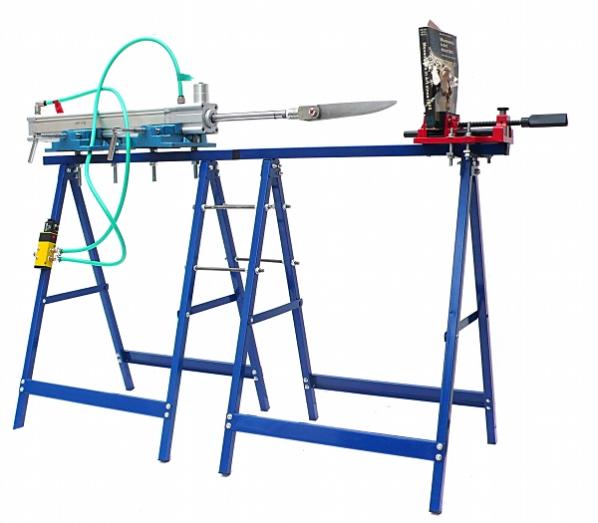
This is shown alongside Data Entry, a video that investigates how databases operate on us and through us by looking at the work of midwives and women in labour. “Databases move through us, allowing new forms of power to emerge… [they] order, compare, sort and create new views of the information they contain. New perspectives amplify, speed-up and restructure particular forms of power as they supersede others.”
Edward Picot is an artist and writer who also works as an administrator in the UK health service. His seriously funny soap-gone-wrong, Dr Hairy In…, chronicles the trials, tribulations and cogitations of an ordinary (but slightly hirsute) general practitioner – with hilarious results!* Dr Hairy’s struggles with NHS bureaucracy are brought to life in a series of satirical video shorts, featuring puppetry performances given by a child’s doll and screened in a doctor’s waiting room, as an installation. “It was like watching Team America set in the NHS” says Ian Hislop (broadcaster, editor of Private Eye and NHS patient).
Kimathi Donkor‘s Toussaint Louverture at Bedourete is a history painting made with oils on canvas that depicts an icon of anti-slavery struggles who, in his lifetime, was smeared as a reprehensible war lord. Created to mark 200 years since the independence of Haiti, the image shows the leader of the Haitian 1791-1804 revolution in a pose reminiscent of the Jacques Louis David’s Napoleon Crossing the Alps, surrounded by inspired revolutionaries in a battle that led to the creation of Haiti as the first slave free nation in history. In a short film by Ilze Black, Dr Richard Barbrook and Fabian Tompsett of Class Wargames interview Donkor about the work.
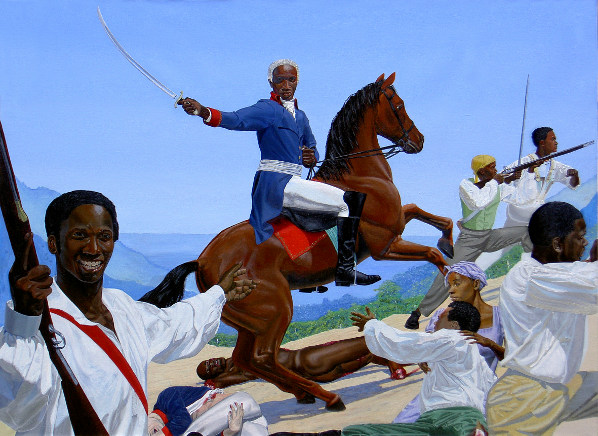
Laura Oldfield Ford‘s recent drawings are the result of walks (or ‘Drifts) through deserted urban spaces in the part of East London being prepared for the 2012 Games. They depict layers of failed utopias of the past and present and imagined futures. Known for her poetic and politically tuned ink drawings produced in print and online in her zine Savage Messiah, Oldfield Ford documents her psychogeographic explorations, in text and image, of the city as a site of social conflict, melancholy and political resistance.

Net artist Dave Miller presents two agitprop posters and a pamphlet of images reproduced from his interactive, multi-layered, online narrative bankers_bonuses. Miller worked with software he created himself to combine hand drawn illustrations with images gathered from Internet searches, and provocative (sometimes preposterous) statements made by powerful people about the ethical questions arising from the economic crisis.
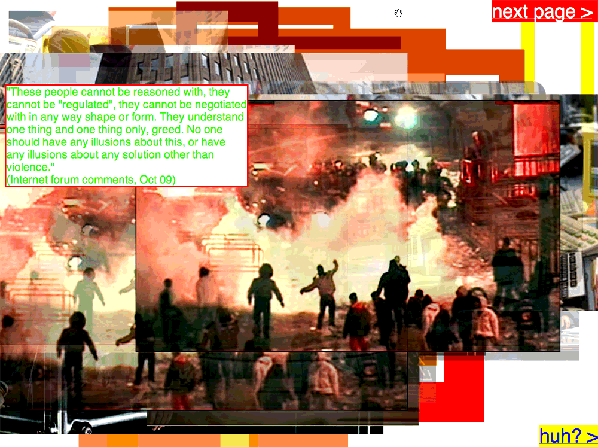
Italian artist group IOCOSE has created A Crowded Apocalypse, a net art project that exploits crowd sourcing tools in order to simulate a global conspiracy. The “crowd” assembles its own conspiracy and then protests against its protagonists and effects. A Crowded Apocalypse is commissioned by AND Festival and Furtherfield.
As we scan our cultures for maps, role-models, possible ways of living in today’s world, we often encounter images of society that are created by its hidden, controlling forces. By naming, revealing, tracking, playing, making, subverting and transforming tools, circumstances and figures that give rise to current crises we enlarge the debate and extend our freedoms. And the artists in this exhibition offer examples of just some of the ways in which this might be done.
* Important note. Dr Hairy In… is NOT a critique of socialised medicine and so we include a disclaimer: “The creators of this piece would like to point out that they all work in the National Health Service and are completely devoted to it.”
Free public play, games, making and discussion run alongside the exhibition.
Led by Dave Miller, The Hexists, Class Wargames, Olga P Massanet and Thomas Cade Aston. See HERE for details.
Rachel Baker (The Hexists)
Rachel Baker is a network artist who collaborated on the influential irational.org. Her art practice explores techniques used in contemporary marketing to gather and distribute data for the purposes of manipulation and propaganda. Networks of all kinds are “sites” for Baker’s public and private distributed art practice, including radio combined with Internet (Net.radio), mobile phones and SMS messaging, and rail networks.
Kayle Brandon (The Hexists)
Kayle Brandon is a inter-disciplinary Artist/researcher, whose work is sited within the public, social realm. She predominantly works in collaborative and collective fields; a working method which informs much of her ethos around the making of art. Her main areas of interest are in the relationships between the natural and urban worlds and Human/Non-human relations. She investigates this field via physical intelligence, provocative intervention, observation, self-guided exploration and collective experiences.
Class Wargames
Class Wargames is an avant-garde movement of artists, activists, and theoreticians engaged in the production of works of ludic subversion in the bureaucratic society of controlled consumption.
The members of Class Wargames are Dr. Richard Barbrook, author and senior lecturer in the Department of Politics & IR at the University of Westminster; Rod Dickinson, artist and lecturer at University of the West of England; Alex Veness, artist and co-founder of Class Wargames;Ilze Black, media artist and producer; Fabian Tompsett, initiator of London Psychogeographical Association and author; Mark Copplestone, author and figure designer; Lucy Blake, Software developer; Stefan Lutschinger, lecturer, artist and researcher; and Elena Vorontsova, World Radio Network and journalist.
Kimathi Donkor
Kimathi Donkor lives and works in London. He attained his B.A. at Goldsmiths and an M.A. at Camberwell College of Art, both in Fine Art. In 2011 he received the Derek Hill Award painting scholarship for the British School at Rome; and, in 2010, his paintings were exhibited in the 29th São Paulo Biennial, Brazil.
IOCOSE
IOCOSE has been working in Italy and Europe since 2006. It organises actions in order to subvert ideologies, practices and processes of identification and production of meanings. It uses pranks and hoaxes as tactical means, as joyful and sound tools. IOCOSE thinks about the streets, Internet and word of mouth as a battlefield. Tactics such as mimesis and trickery are used to lead and delude the audience into a semantic pitfall.
Dave Miller
Dave Miller is a South London based artist and currently a Research Fellow in Augmented Reality at the University of Bedfordshire. Through his art practice Dave draws out the invisible forces that make life difficult. His work is about caring and being angry, as an artist. His art enables him to express feelings about the world, to attempt to explain things in a meaningful, yet subjective way, and make complexed information accessible. Recurrent themes in his work are: human stories, injustices, contentious issues and campaigning. Recently he’s been very bothered by the financial crisis.
Laura Oldfield Ford
Laura Oldfield Ford lives and works in London. She studied at the Slade School of Art and completed her MA Painting at the Royal College of Art. She has exhibited extensively including Rokeby and Hales galleries in London, Savage Messiah takes over Late at Tate Britain, The Arnolfini, Bristol , De Appel Amsterdam and the Goethe Institute, New York. She has also recently been commissioned by Art Review. She is currently working on new projects for the Shenzhen Sculpture Biennial in China, the 2012 Gwangju Biennial and the show ‘Desire Paths’ at the Caja Madrid in Barcelona. A compilation of her zine ‘Savage Messiah’, which documents her psychogeographic drifts through London, is available on Verso books.
Edward Picot
Edward Picot was born in 1958. He lives in Kent with his dog, wife and daughter, not necessarily in that order. He earns his living as a Practice Manager in a doctor’s surgery, and in his spare time he does creative things – usually at the low-tech end of the new media spectrum. He started the Dr Hairy series – humorous short puppet-videos about a fictional doctor, closely based on his own experiences of working in the NHS – in 2010.
YoHa
Graham Harwood and Matsuko Yokokoji (YoHa – English translation ‘aftermath’) have lived and worked together since 1994.
YoHa’s graphic vision, technical tinkering, has powered several celebrated collaborations establishing an international reputation for pioneering critical arts projects.
Harwood and Yokokoji’s co founded the artists group Mongrel (1996-2007) and established the MediaShed a free media lab (2005-2008). In 2008 they joined Richard Wright to produce Tantalum Memorial shown in 9 countries and 15 cities over 4 years. In 2010 YoHa produced Coal Fired Computers before embarking on a series of works about the lived logics of database machinery including Invisible Airs, Data Entry in 2011 and Endless War in 2012.
Furtherfield Gallery
McKenzie Pavilion, Finsbury Park
London N4 2NQ
T: +44 (0)20 8802 2827
E: info@furtherfield.org
Furtherfield Gallery is supported by Haringey Council and Arts Council England
Dave Miller’s bankers_bonuses is supported by KAY MOUNTING.
Featured image: Artist Suguru Goto discusses his work.
London 2012: there is of course one event which springs to mind when we think about this city and the year we’re in, but there is also another significant event happening in London right now, one which is very important for the digital and media arts world. It is the year that Watermans Arts Centre is holding the International Festival of Digital Art 2012.
As well as showcasing an array of digital art by internationally renowned artists, the programme also offers the opportunity for members of the public to get involved in discussions around themes that the Festival touches on through the seminar series accompanying the shows. These are in collaboration with Goldsmiths, University of London. Nearly three months in, the Festival has launched two exciting shows,Cymatics by Suguru Goto and UNITY by One-Room Shack Collective.
The first show, Cymatics, is a kinetic sound and sculpture installation that expresses Goto’s vision of nature. To enter it, the audience step through a door into a boxed, dark room within which they are presented with a touch screen interface, a shallow metal tank holding water and a screen showing a video feed of the water in the tank. The piece invites the audience to move the water in the tank by manipulating sound waves via an interactive screen. The result of the interaction is a stunning variety of geometric shapes, demonstrating the distortion that sound waves can have on a substance. This occurrence reveals the bridge between technology and nature, which fits into Goto’s re-occurring theme within his work of the relationship between man and machine.
The seminar which coincided with the show, Interactivity and Audience Engagement, was chaired by Régine Debatty and featured on the panel Tine Bech, Graeme Crowley and Tom Keene, all who which explore audience engagement in different ways within their work. Tine Bech is a visual artist and researcher whose installations invite audiences to engage in playful interactions, from chasing a motion reactive spotlight in Catch Me Nowto sound triggering shoes in Mememe. Tom Keene is an artist technologist whose focus intersects participation, communication and technology. His work is multidisciplinary, investigating the way we communicate, mediated by technology. His practice is diverse, from exploring the potential relationships between networked everyday objects in Aristotles Office to inviting a community to comment on their local issues through signs in Sign X Here. Graeme Crowley is a designer and artist who has created installations for prominent public areas, including The Wall of Light, commissioned by Arrowcroft Plc for the centre of Coventry and Spiral/Bloom commissioned for a hospital in Rochford by the NHS.
I found the juxtaposition of these three practitioners very interesting as each of them explore the interaction between audience and technology in varying ways. Bech’s work is very tactile and sculptural, almost making people forget the technology behind it. She likes to look at technology as something we can mould and which can be used to explore the wider issues which art can bring up, rather than just focussing on the tech itself and how ‘shiny’ (to use her own term) it is. In contrast to this, within Keene’s practice technology feels very prominent, visually as well as conceptually. Crowley’s focus is different again as it mostly operates within the commercial sphere. It therefore is produced for greater public consumption and needs to withstand being a permanent exhibit, becoming part of the architecture it is planted on rather than something which is temporary. The talks given by each panel member and discussions which accompanied them were all diverse and brought up interesting points around the idea of audience engagement and interactivity. Members of the audience entered into these discussions with ease, creating an open dialogue which itself was participatory and engaging.
UNITY, by One Room Shack is the current exhibit as part of the International Festival of Digital Art 2012, bringing a piece of work to the gallery which aims to embody the Olympic spirit, visually as well as conceptually.
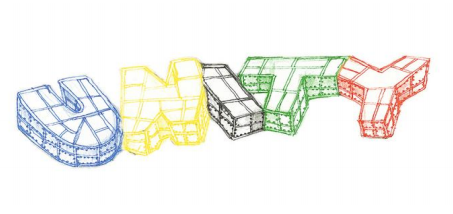
Design for Unity
The installation takes the form of a transparent maze, angular in its structure and illuminated with different coloured LED lights in each section. Each illuminated section of the structure forms a different letter, all together spelling the word ‘unity’. As the audience navigate their way through the installation, their movement is picked up by motion sensors, triggering the LEDs at each point to turn on. These each represent a particular colour of the Olympic rings.
The ideologies of the Olympic Games linked with an immersive space explores the value of ‘being together’, something which the African humanist philosophy Ubuntu also speaks about.
UNITY is effective in exploring the theoretical concepts embedded within it through a playful and simple interactive structure. As an individual you step from section to section with the different groups of LEDs individually illuminating you as you go through the work. When a group of people interact with the piece at the same time however, the piece lights up as a whole, echoing the values of being together that UNITY invites us to explore. It is through enabling this experience, that the work celebrates and explores human connections.
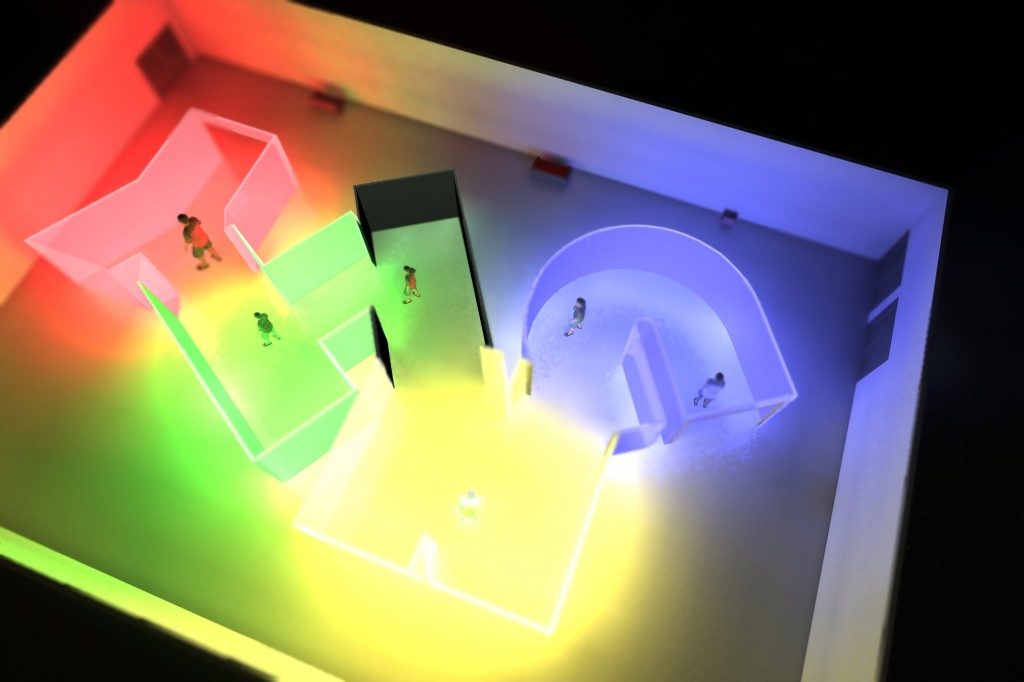
I do find it interesting how the piece has such a strong stance towards the more idealistic ideologies of the Olympics, especially when taking into account the anti Olympics sentiment present in London. The event does bring people together, but unfortunately as we’ve seen in East London and also at previous Olympic locations across the globe, they also have the ability to put local communities at risk through rising rents and eviction [1]. UNITY looks at ‘…understanding the implication of UNITY on humanism in a neo-liberal world where hyper-capitalism and love of excess trump compassion and selflessness.’ [2] but in reality, the Olympics have unfortunately become something which arguably embody these traits. This said, I do think that UNITY is an incredibly beautiful piece in its visual execution and that its interaction compliments the theoretical idea which it is looking to address.
I look forward to the remainder of the International Festival of Digital Art 2012 and the eclectic ideas within media and digital art which the programme explores. I interviewed Irini Papadimitriou, Head of New Media Arts Development at Watermans, about the Festival:
Emilie Giles: First of all, can you tell us what the premise is behind the International Festival of Digital Art 2012?
Irini Papadimitriou: The idea behind the Festival started from a decision to develop a series of shows that could form a discussion rather than being one-off exhibitions and help engage more people in the programme. In the last year we have been focusing more in participatory and/or interactive installations so I thought it’d be interesting to dedicate this project and discussions in exploring more ideas behind media artworks that invite audience engagement as a way of understanding our work in the past year.
Since this was going to take place in 2012 we felt it would be necessary to open this up to international artists so this is how the open call for submissions came up last year. We received so many great proposals it’s been very hard to reach the final selection, but at the same time the opportunity of having a year-long festival meant we could involve as many people as possible and hear many voices not only through the exhibitions (this is just one part of the Festival) but also with other parallel events such as the discussions, presentations of work in progress by younger artists and students, the publication, a Dorkboat (coming up in June with Alan Turing celebrations), as well as collaborations with other organisations or artists’ networks and online.
EG: Touching on your last answer, the Festival has a clear aim then to engage people in discussion rather than just being viewers of a show. Do you think that within media and digital art there is a particular need for this approach?
IP: I think that hearing people’s thoughts and responses and enabling discussion is important for all exhibitions and art events but specifically for the Festival (since the aim is to question & explore audience participation). It was very relevant to hear ideas and views from other artists, technologists, practitioners etc but also audiences, rather than just the participating artists.
Also, and this is my view, I think as media and digital art use technologies that many of us are not particularly familiar with or if we use technologies it will be most probably as consumers, it’s important to talk about and discuss the process (as well as impact of technologies) both for the artists as well as for audiences.
EG: The themes chosen for the programme are diverse and each relevant to media and digital art in their own way. What are the reasons for each focus and why?
IP: The themes explored in the Festival result mainly from the selected proposals and discussions with the artists. There were so many things to talk about so having these themes was a way to start from somewhere and help understand better the installations shown throughout the year. The seminars that we are organising are an opportunity for the artists to talk about their work and share their ideas with both audiences but also with other artists invited to take part in the panels. It is also a way of discussing these themes and presenting other work that raises similar issues. The seminars are shaped around the themes such as perception and magic in digital art, sound and gesture, geographies, virtual spaces as artistic mediums and of course participation and interaction. We are currently working on a publication with Leonardo Electronic Almanac which will be coming out in the next couple of months and will include essays from artists, academics and students as well as interviews with the artists behind the selected proposals. Again the catalogue has the Festival themes as a starting point but we tried to combine different content and ways of communicating these.
EG: How do the pieces featured in the exhibition question audience engagement, participation and accessibility ?
IP: The artists presenting work are exploring participation and audience engagement in different ways and I think we will have also interesting outcomes from the seminars and the publication which will allow us to explore these ideas further.
In the current installation, UNITY, One Room Shack collective are using the playful structure of a maze (in the form of the word UNITY with each letter lighting up in the colours of the Olympic rings) inviting people to walk inside to reflect and draw upon the complex nature of human reality and ‘difficult’ aspects of human existence.
Michele Barker and Anna Munster who will be showing HokusPokus later on are interested in exploring how we perceive actively in relation to our environment, how we see, what we see and how this makes us ‘interact’. HokusPokus inspired from neuroscience examines illusionistic and performative aspects of magic to explore human perception, movement and senses. The tricks shown in HokusPokus have not been digitally manipulated; they will unfold temporally and spatially, amplifying and intensifying aspects of close-up magic such as the flourish and sleight of hand.
The Festival will close with an installation by American artist Joseph Farbrook, Strata-Caster, which was created in Second Life mirroring the physical world, exploring positions of power, ownership, identity and drawing parallels between virtual and physical worlds. An interesting and important part of the installation is the use of a wheelchair by visitors to enter and navigate Strata-Caster.
EG: How have the 2012 Olympic and Paralympic Games inspired the Watermans International Festival of Digital Art?
IP: As we are trying to explore what participation is we thought it would be an interesting link (rather than inspiration) between the Festival and the Games/Cultural Olympiad since they are meant to symbolise, promote and inspire values like creativity, collaboration, participation, engagement etc. The Festival isn’t about the Olympics and participating artists didn’t have to propose work that linked to the Games, but we did receive many proposals that reflected on the Games, what they represent and the meaning of participation, so some of these proposals are being shown as part of the Festival, such as One Room Shack’s UNITY and Gail Pearce’s Going with the Flow.
Darko Aleksovski interviews artist Toni Dimitrov about his work ‘Total surveillance’ featured in the group exhibition SEAFair ’11 ‘Energy, Biopolitics, Resistance strategies and Cultural subversion’. Curated by Melentie Pandilovski, Elena Veljanovska, Zoran Petrovski, ending on the 20th November at the Skopje Museum of Contemporary Art, SEECAN (South East European Contemporary Art Network) and Kontejner, Zagreb. SEAFair 2011 contextualises the artistic and theoretical discourses developing around Bio-politics, aiming at re-evaluating its meaning today, as well as address the possibilities for resisting the dominant international discourses through emancipation and cultural subversion.
Darko Aleksovski: Inspiration is a term which has been differently interpreted throughout the history of art, but generally implies the genealogy of the idea. What was the main inspiration for a project like this? Can you tell us about your references (other similar projects, theory, philosophy, etc)?
Toni Dimitrov: Throughout the twentieth century, art changed its forms of representation. Representation through painting, making objects and visual contemplation, and prior to all – the mimesis – artists changed them with new ways of representation which more and more directly respond and represent the changes in the society, emphasising process, concept, action, interaction, new media, technology, surroundings and of course, the critical discourse… The thing that challenged, and still challenges me to express is the critical discourse and the resignation which is a result of the systematised life and the limitations of the system. It is that primordial anger which one feels at the moment of gaining awareness, when we actually realise where and how we live. Everything that is presented to us as a system that aims to ease our life, is not actually quite so. Take for instance, science and technology, and their goal to “work” for the benefit of humanity. It is not just that they do not seem to make life easier, but on the contrary their usage is harmful for humanity. Exactly from the moment when the greatest hopes were given to technology, science and the great theories, they seem to have failed to fulfill the expectations. Instead of being tools for achieving the ideals of humanity and attaining prosperity, they are becoming the most powerful tools of the system for establishing new forms of power and domination. That same indignation generated from this cognition is my greatest inspiration, from my first critical artwork, through to some other art project, different philosophical essays, and until now.
As inspiration from philosophy, primarily I can mention Baudrillard and Virilio, who precisely vivisect contemporary reality. Then my greatest interest for the utopians and anti-utopians from More and Campanella, who criticise the system at the moment by offering a solution, and all the way to Orwell, Zamyatin and, of course, Huxley, who gives the most precise image of the society we live in – benevolent totalitarianism. I also need to mention the Frankfurt School through From, Horkheimer, Adorno and of course Markuse and other contemporary scholars like Zygmunt Bauman, Ulrich Beck, Frank Furedi, Lars Svendsen…

Darko Aleksovski: To which extent digital media is important for you as an artist? Do you regard the digital artworks to be carriers of more information in a present day digital surplus, or you think that art necessary expresses through digital media because it is the prevalent media in today’s life? How much is the ready-made aspect of this project necessary?
Toni Dimitrov: Digital art affirms all these social changes and at the same time offers a departure from them, leaving different questions from different areas in the center of the discussion. Unambiguously, digital art develops wider contexts and penetrates in other different fields like philosophy, physics, linguistics, semiotics, politics, sociology, even biology. When you visit an exhibition like this, you no more have the feeling that you are at an exhibition where you should experience something beautiful, but you feel like being in a lab where something new is created, something unacceptable even for science itself. Ethic rules and scientific methods have no significance here. Some of those works went too far and by looking at them, you are likely to feel disgust or resignation, feelings that are important for expressing the critical dimension and gaining awareness.
Concerning the ready-made aspect of the digital art, we have to agree with Walter Benjamin, who considers that through making reproductions, the unique experience is replaced by many others and the replication contributes to the loss of the aura of the artwork, with the fact that the artwork through the process of distribution, is not so original, unrepeatable, unique, but can be reproduced and replicated. Simply, the uniqueness of the original is transformed in infiniteness or many others. That is one of the main critical perspectives addressed towards the art that originates after the mechanical reproduction and the development of arts such as film, photography, printmaking, and today we can include a wide variety of digital arts, where practically the original is not present. Here art loses its uniqueness, or aura to be more precise, but receives the “readiness” of the ready-made aspect.
Besides this critique with which I agree, I still think that art/music are created today to be seen/heard today, and not after ten years when they will be a part of the history. This means that art today is created with digital tools and digital media, equally as electronic music is created. In my opinion one should be current and to express through momentary assets, in order to express and present the new social and critical streams more precisely. On the other hand, this does not mean that we should not use classical media in a contemporary way and that I do not draw, or even make a mosaic, but still “officially” I use digital media and conceptual art to express myself and to address a critique.

Darko Aleksovski: Do you consider your project as a critique towards the social apparatus and the instrumentalised life, or towards the inert subject, instructed to accept ready-made social situations?
Toni Dimitrov: Of course the critique is directly addressed to the society and the system. Society is the one who possesses the monopole of power and imposes these aspects of subtle, total control. However, the subject itself is not spared from the critique, precisely because of his inertness, because he does not react against this imposition, but unconditionally accepts it under the vague excuses that all of it is for “his own good”, for his security, protection, etc. Still this imposition is generated by the system, through the upbringing, educating and modeling of the subject itself, so it is more than obvious who is to blame for this condition.
“Total surveillance” addresses the critique towards one of the most explicit “benefits” of contemporary society, which is so much present in our everyday life, that we do not even notice it. The project refers to the anti-utopian dimensions society gets in today’s context. The exposure to constant surveillance is the subject of the anti-utopian works, which precisely anticipate the consequences of irregular use of technology, and the philosophical dimension of which totally corresponds with our present.
It is in these points that we see the postmodern analysis of institutions and discourses of modern art and the ways in which they normalise and discipline the subjects, analyses of the new communication technology, mass-media and their mechanisms of establishing power and domination… We see a critique directly addressed towards today’s modern forms of power which establish new forms of domination. The critique towards information and communication technologies that contribute to the development of human capacities, decomposition of the centralised structure and concentration of power, democratisation of culture… as much as they contribute to the depersonalisation of individuals and manipulation of people.
The realisation of this progress is a vision of the anti-utopia made real, realisation for which time is becoming increasingly shorter. Today we see that, the anti-utopian predictions for the negative consequences of technological and social development are realised with surgeon’s precision, in all of its wide variety, realised through social restrictions, concentration of power, social insecurity, depersonalisation of the individual, destroying of the emotions, control via mass media, mass production, instant entertainment… All these are described and anticipated by the smallest detail, in the works of the anti-utopians years before they became reality.

Darko Aleksovski: Do you see art as the most relevant way for critical actions?
Toni Dimitrov: No. Art is just one, maybe the most banal, but still most receptive way of critical action which will not leave many traces in reality. Art is a paradigm which represents things in a symbolic way. That does not mean that art is insignificant and that there are not examples of art and its critique generating a change or at least raising awareness of some issues, but still it is an accompanying method for addressing direct critique. Theory/ philosophy MUST be inevitable part of the art through which it gets the crucial point for a direct critique and eventually initiating changes. Art without theoretical basis is nearly empty art.

Darko Aleksovski: Your project is a vicious circle copy of the surveillance cameras. To which extent this artistic situation is a replica of the real one, or you consider the real situation to be even worse? How much you think engaged and critical art are perceived nowadays, considering the dispersed art system?
Toni Dimitrov: Unfortunately too true a copy of reality. When you enter the exhibition room, you practically enter a real situation, i.e. you exit in the social reality. This is practically a copy of the social system which we live in. In that case there is no need for gradation of better or worse situation. Go out on the street, pass by the surveillance cameras and feel it. There were mixed reactions when visitors entered the exhibition room, most of them were real, expressed with unpleasant feeling and disgust when they realise they are uncoated and observed from every side. It is the very same thing that happens in every institution and outside on the streets, but we are unaware of who is observing us. That is the feeling I conveyed here; the feeling when you see the results of the observation. It is a precise reflection of the anti-utopian character of our society which develops in this direction mediated by technology.
On the other hand the technological revolution that happened in the last fifty years and the IT revolution created in the digital age, also created fundamental changes in society and the way it functions, even in the physical space. For Virilio, even reality is divided or more accurately it is substituted with another – a virtual one that becomes more powerful mediated by the new technologies. That is why the essay that goes along with the installation begins with a quote by Virilio: One day the virtual world might overwhelm over the real world. This is that same virtual reality in which monitors you look at your existence. It is Virilio that warned us that almost every critique toward the technology disappeared and that we unconsciously accept every innovation without critical view on its consequences, by which we slip in the dogmatism of totalitarian techno-culture. All of this is criticising the way technology changes the contemporary world and human himself, recognising a key factor in technology that determines the modern world.
Finally “Total surveillance” represents a kind of video installation or a network/structure composed of video cameras, video projectors and screens which mutually intersect and constantly record the object/viewer in front of them, from every angle. The viewer, with his/her presence is a participator and part of it at the same time. The cameras record his presence from all four sides, and the viewer is capable of watching the recordings on the screen in front of him i.e. to watch himself. It is about the total surveillance of the viewer, but one in which the viewer is under surveillance by himself from every side and perspectives which are usually invisible for him. In the surveillance, other viewers in the room are also included, by watching themselves, or by watching other viewers. With this, you get a network of crossed cameras and projectors which project images of the viewer from every side, fill the whole room and complement it with the visual noise of the space. This replication and reproduction creates a projection of the viewer in the screens, outside himself, in a sort of virtual world, which continues to infinity, similar to a mirror projected in another mirror, gaining new and new aesthetical forms, a product of the replication and reproduction of themselves.
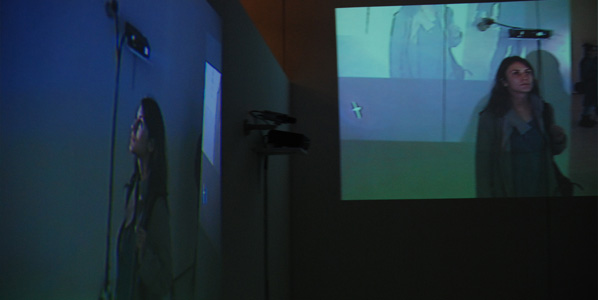
More information about the project and the artist: tonidimitrov [at] gmail.com
All images by Ilija Madzarovski.
On 28th October 2011, I travelled to Sète in the South of France to see and review Annie Abrahams’ show Training for a Better World.
The first of two reviews (the second will be somewhat longer and in an academic journal later this year) is now available on DVblog.
What was particularly pleasing about going to the press view and then staying on for the opening proper was the opportunity to engage with the work over quite a long period – some four hours.
About halfway through the evening, I started both photographing and sketching as aides-memoire for my reviews, but I soon began to enjoy the feeling of responding to the work for its own sake, and I began to think about presenting the drawings and photographs (plus some drawings made from the photos two days later, as well as a couple of manipulated photos) as a kind of photo-essay/derivative work.
Featured image: Healing Station. mixed media, interactive installation, size variable. Christy Matson and Jon Brumit, 2009.
The New Materiality: Digital Dialogues at the Boundaries of Contemporary Craft.
March 10–June 12, 2011
Decorative Arts Gallery
http://www.mam.org/exhibitions/details/new-materiality.php
For the first half of the 20th century, curator Fo Wilson reminds us, the practice of craft was heralded as a “remedy” to how human values were changed by the Industrial Age. Here the hand-made was given privileged status over the machine-made, and thus craft forms gifted new value through the artisan. In the latter part of the last century, as the world moved from apprenticeship and artisanship to a more intellectual and theoretical-based framework for valuing contemporary art, so too have craft practices and discourses been challenged. This rethinking of craft has accelerated in the last several years, with books like Glenn Adamson’s Thinking Through Craft and Howard Risatti’s A New Theory of Craft (both 2007), both arguing for conceptual rigor and provocative possibilities within craft as a discipline.
The New Materiality: Digital Dialogues at the Boundaries of Contemporary Craft, an exhibition that began at the Fuller Craft Museum and is currently up at the Milwaukee Art Museum (MAM) until June 12, follows on and extends current trends in contemporary craft. It engages not only with craft’s reinvigoration as a creative practice and discourse, but with how these have been shaped by, and also transformed, new technologies, new designs, new materials and new ideas. Wilson’s exhibition and events make discussions around Art or Craft, Art or Design, Digital or Hand-made, and Conceptual or not seem, in a word, quaint; she engages with a broad set of materialized ideas that divide and relate across the artistry of craft, the ephemera of technology, and the theoretical frames of post-conceptual art.
The exhibition can perhaps best be summarized through the work of the four exhibiting artists/artist teams that spoke at the “Dialogues on Innovation” panel at the Milwaukee Art Museum on April 16th. Collaborative artists Donald Fortescue and Lawrence LaBianca, for example, spoke to Milwaukee activist and printmaker Nicholas Lampert about their piece, Sounding. This work consists of a huge, custom built cabriole-legged table, which was initially filled with beach rocks and sunk to the bottom of the ocean. There it lay, for two months, with a hydrophone to record the ambient sounds of the sea, including the overwhelming swish of waves, the low hum of slow-moving current, and the activity of sea life – the most prominent being the continuous clicks of what must be shrimp in its vicinity. When the artists’ creation reemerged, it brought the bottom of the ocean with it: all the messiness and stink and poetry of the sea – barnacles, rusty parts, plant life, fish scents, mystery and more. It is exhibited with an over sized hornlike funnel, a huge phonograph tied together with zip ties, to amplify the recorded sound.
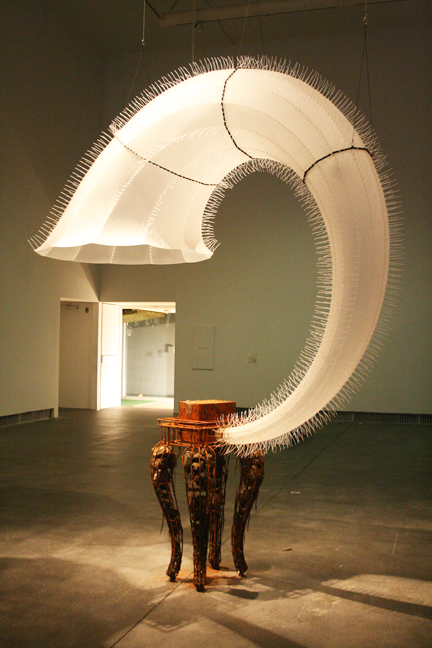
Sounding, avowedly inspired by Captain Ahab’s hunt for an un-killable whale, acts as a kind of parallel to the ongoing hunt for singular disciplinary focus in craft. The piece dives into the sea, hits “rock bottom,” and looks as if it barely survived; and on its return, we see that Sounding is far from a singular entity. Yes, it is trashed and torn, but it’s also imbued with literal life, entwined with technical innovation, and rich with stories of its journeys. Like the theories and practices behind the current craft movements, it came back more beautiful, more visceral, more sensory, and more technological than it ever was: a new materiality.
You can listen to or download Sounding file here:
http://www.furtherfield.org/audio/Soundings-1.mp3
My discussion with artist Christy Matson revealed an exploratory practice that shifts between digital and hand-made, generative and interactive, and always with an eye towards the implications of each. Soundw(e)ave, her piece on show, is a self-referential textile, where the actual sounds of computerized Jacquard looms were used to create woven compositions. Her noisy sound waves were turned into three patterned pieces of fabric, made by hand-operated, computer-assisted and fully automated (Jacquard) looms, respectively – each weave growing progressively denser with the more advanced technologies used in their production. The piece, says Matson, was a huge turning point in her practice; it pointed her towards a kind of digital craftsmanship, where she was better able to place value on the ideas, materials and skillfulness needed to be an artisan across contemporary digital, craft and art domains.

Soundw(e)ave, generative weaves, triptych (each 34″ x 54″). Christy Matson, 2004.
For example, Matson then began weaving copper wire directly into her fabrics, and, using the magnetic waves our interactions generate and alter, engendered new aural compositions. In other words, her sonic sculpture turns cloth into a Theremin, where movement and hand-waving at the gallery are transformed into the kinds of musical gestures often associated with science-fiction films of the seventies. While Matson’s earlier, sound-generated works were generative and performative on some level, here she moves into real-time interaction, invoking our embodied relations to textiles, craft, technology and language, all in one fell swoop.
healing station, a collaboration with Jon Brumit and quite possibly the most complex of Matson’s installations thus far, sees piezo sensors placed inside of swaths of fabric to pick up the ambient sounds of the room – including gallery-goers, passersby, street sounds, and the minute vibrations in the fabric itself. This lovely noise is then fed back into the space with bass shakers: speakers optimized for sending waves into solid media rather than air. Viewers can literally feel the low hum of presence, absence and movement as the textile, bodies and room speak at and to one another in a perpetual feedback loop of embodied music. The small crowd at the MAM laughed along with Matson when she relayed a story in which her wired-up piece, and its feedback, caused a small fire at one of its showings – quite a performance, indeed.
Tim Tate artfully explained to Milwaukee staple Tom Bamberger that nowadays “craft” is a starting point rather than an end point. I’m paraphrasing here, but he treats craft as an approach, a space of understanding materials, what they’re good at, perhaps their “habits,” and most certainly their implications. Here, narrative, function and the conceptual are always already implicated across technique – whether new or old – and value is derived from a contextual corpus.
Tate’s work is itself a beautifully resolved hodgepodge of hand-blown glass, hi-tech LCD screens, and visceral videos of typewriters and books, all literally tied together with plastic (zip ties again – don’t knock it ‘til you try it!) around a printed circuit board. In Virtual Novelist, for example, miniature monitors display the aforementioned “dead media” tools from behind artefactual casings of glass. Atop are beguiling sculptural homages to each of the gone-but-not-forgotten analog recording devices of yesteryear.
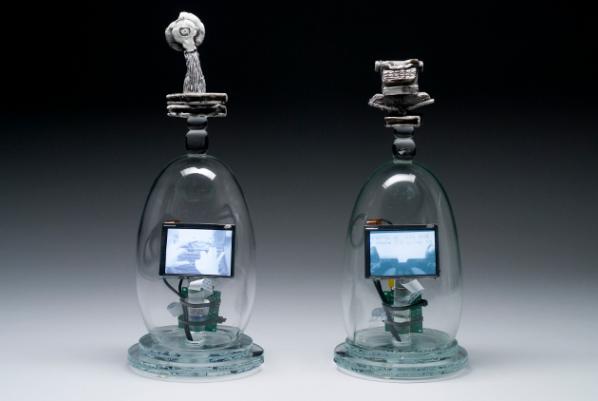
Bamberger is a smart artist with a quick wit, and Tate is similarly not one to spar with unless you have a good grasp of the discourses at hand. In this lively thirty-minute discussion, the two managed to disarm the Art vs Craft debate as both unproductive and long-since over, and open up possibilities for “ornamental aesthetics” in time-based media. Here the implication was that, following Tate’s lead, video objects and installations could place more emphasis on the object and installation – rather than the video – and use each as an equal material that informs and plays off of the other; the video and screen need not be the central focus.
Sonya Clark then told us how she views her practice as a fiber artist as similar to how author Toni Morrison views her own writing practices. In one of her essays (found in several publications, including a collection entitled What Moves at the Margin), the latter tells a story of the Mississippi River, which was laboriously straightened for travel and transport by boat. Every so often, the river floods; but, Morrison goes on, it’s not really flooding. It is remembering. The water is trying to get to where it belongs, to re-member, to embody again. Morrison says writers do the same with their texts; and Clark claims that she remembers through her materials. Originally trained as a fiber artist and now working across found objects, digital art and more, Clark’s practice sees her reclaiming forgotten histories, and giving them greater potency through her processes and media.
Clark discussed this approach with longtime friend and former colleague, UW-Madison Professor Henry J. Drewal – one of the foremost thinkers surrounding African Art. Clark’s brilliant work on the exhibition, a portrait of Madam CJ Walker, is constructed entirely out of small, acrylic and thin toothed, black hair combs. She overlays the combs and removes some of their teeth to make a huge, grayscale, and literally bit-mapped image.
Madam Walker, the first ever female millionaire in America (and African American to boot), made her fortune selling beauty products to black women hoping to straighten their hair – as was the fashion of the time. And so Clark utilizes her combs, with their own memory, narrative and political weight, to construct a lo-resolution digital image. This exceptional work manages to explicitly straddle issues of race, gender, class, memory and materiality on its very tactile surface, and implicitly engage with the contemporary conceptual frames of digital art and data, in its transcoding of the image from one form to another, and craft, in the final material and hand-made form it takes.
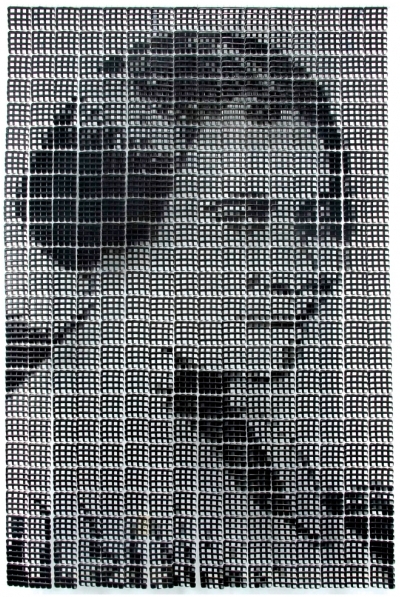
Clark finished with the generous idea that, at present, all art work is collaborative in that it fits into broad social and cultural contexts, builds on extant technologies, and is produced, received, and engaged with outside of the individual’s studio. And Drewal concluded by declaring that technology has always been at center of the arts in the form of new techniques. When something comes into the world, he went on, whether technical or formal or as an image, artists take it someplace else. They “turn common objects… into uncommon things, stretching our imagination and the world” along with them.
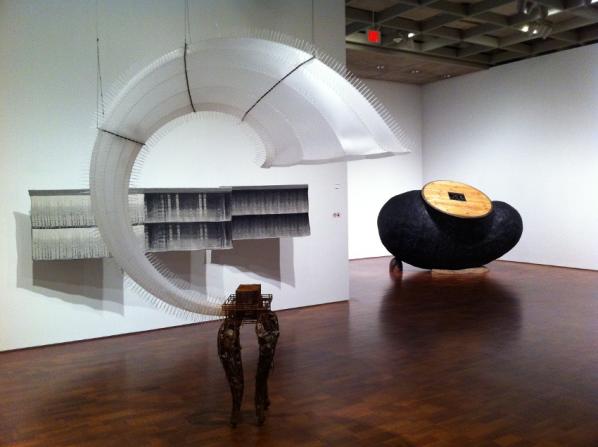
These are just a handful of the works in The New Materiality, by four of the artists represented in our discussions – not even all the works they contributed, much less those of the other artists, which include Brian Boldon, Shaun Bullens, Lia Cook, E.G. Crichton, Maaike Evers, Wendy Maruyama, Cat Mazza, Nathalie Miebach, Mike Simonian, Susan Working, and Mark Zirpel.
It is a show that, in its entirety, succeeds in stretching our imagination, through its expansion of craft, art and digital forms, and what they individually and collectively mean today.
Nathaniel Stern (USA / South Africa) is an experimental installation and video artist, net.artist, printmaker and writer. He has produced and collaborated on projects ranging from interactive and immersive environments, mixed reality art and multimedia physical theatre performances, to digital and traditional printmaking, concrete sculpture and slam poetry http://nathanielstern.com.
‘Made Real’, an exhibition by Scott Kildall and Nathaniel Stern, the founders of Wikipedia Art. Can be seen at Furtherfield’s Gallery from 27th May 2011 http://www.furtherfield.org/exhibition/made-real
20 Digital Years Plus
Station Rose
Nurnberg 2010
ISBN 9783869841113
“Twenty Digital Years Plus” is a softback book that presents and contextualises the art of Station Rose (Elisa Rose and Gary Danner) from 1988 to the present. Its gatefold cover conceals both a CD and a DVD which provide audio and video to complement the static images and texts, and carries an endorsement from Bruce Sterling on the back cover.
The book starts with a series of essays before presenting an illustrated history of Station Rose. Those essays approach Station Rose from some refreshing and unexpected angles to make a convincing claim for their art historical interest.
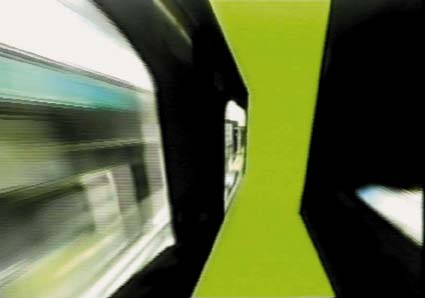
Peter Noever writes in the book’s preface that “Media art is both an art form and a way of life for Station Rose”, a claim that the evidence of the book more than supports and that I think is key to why Station Rose’s art is so interesting. The book functions as a mid-career retrospective, and Noever suitably sets the themes of achievement and continuity.
Vitus H. Weh’s essay explains how Station Rose got their name and puts their LoginCabin project into the context of German post-cold-war architecture and the sociology of the Wild West. We are a long way from the early 90s view of the Internet as a new frontier, but despite its critics that view was not uniquely tied to American society and provided a liberating impetus to individuals who didn’t always subscribe to the Californian Ideology.
Hans Diebner’s critique of net art and activism brings a thought-provoking scientific, techno-art historical and philosophical critical literacy to bear on Station Rose and the artists and activists that he contrasts them with. Diebner weaves together diverse conceptual strands into a coherent critical case without any resort to jargon, and it’s worth thinking through how his case affects our view of net art in general as well as Station Rose’s position within its history.
Didi Neidhart’s interview with Rose and Danner provides context for and insights into how the pair create and conceptualise their work, and how their art and music relate. Station Rose emerge as the product of cultural engagement and lived history rather than academic fashion.
Gabriel Horn writes from a curator’s point of view about the future shock of working with Station Rose in 1991, in contrast to working with them in 1999 when they are part of an intermedia exhibition.
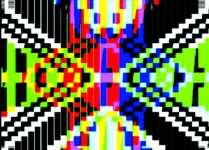
The bulk of the book is an illustrated history of Station Rose. They started out in 1988 as a multimedia lab in Vienna complete with 16-bit Amiga computer. In November 1988 they went online for the first time at the Sampling conference they held in Vienna, having already adopted the technology and concepts of sampling into their art and performance. Since then their work has taken the form of CD-ROMs, live streaming media, live multimedia performance, Internet homepages, CDs and vinyl with Sony records, books, TV shows, multimedia installation, webcasting, lecturing, teaching, and a shed.
Station Rose also create memes, or language, such as the statement quoted by Bruce Sterling on the back cover that “Cyberspace is Our Land”, the much needed identification of the “Digital Bohemian Lifestyle” and the increasingly paradigmatic condition of being “private://public”. Even in an age when the concept of multimedia has largely been absorbed by the Internet their work crosses and assembles different media.
Much of Station Rose’s digital art has the not quite glitch aesthetic of overlayed pixellated form in shallow depth that any serious history of digital art needs to account for. But the cubicles, huts, pillows and panels of their installation work have the same aesthetic. Station Rose’s work is in itself a history of digital art over the last two decades. And this digital art is always in dialogue with physical performance and physical structures, the virtual in dialog with the real to illuminate each other.
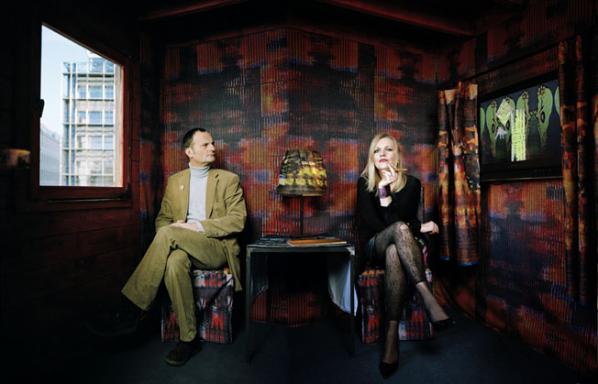
In Neidhardt’s interview, Danner says of Station Rose that “We are quickly bored with things as soon as they become mainstream.” Boredom with the content and products of digital media is the friend of the scheduled obsolescence and cultural amnesia of market mass media. But boredom with the form of and the means of creating digital media can also serve to motivate the creation of successive alternatives to it.
Over the last 20 years the Internet and digital media have gone from being a novelty to being socially and economically pervasive. This rate of change, and the constant promotion of different visions of what the Internet is for by different institutions, mean that our relationship with the Internet has come to be in plain sight. Artists can usefully depict and help us conceptualise that relationship, particularly those artists who can use the digital media that has been drawn into the Internet and become no small part of its operation.
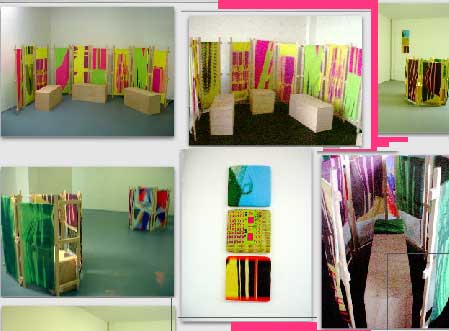
Station Rose are such artists. Their art has the quality of being both the product and producer of lived experience in the age of digital media. It refracts the logistics and glitches of the Internet through the prism of contemporary art’s deceptively low-fi rummage sale aesthetics to present them as objects of contemplation. When digital media was new this served to make them accessible to an unfamiliar public. Now that digital media are pervasive to the point of invisibility, this serves to make them visible again as objects of contemplation and to afford the viewer a critical distance from them.
20 Digital Years Plus is an engrossing, thought-provoking presentation of the ongoing development of Station Rose that makes clear the value of their constantly enquiring relationship to ever changing technology.
(With thanks to @MarkRHancock)
The text of this review is licenced under the Creative Commons BY-SA 3.0 Licence.
Furtherfield is pleased to present the UK Book launch of STATION ROSE: 20 Digital Years Plus, published by Verlag für Moderne Kunst Nürnberg.
DR. Richard Barbrook will give a short introduction to the evening.
The Digital Art of Station Rose started in Vienna in 1988, at a time when the Web still was far beyond mainstream, when Mondo 2000 never had heard about the music genre “Techno”, when future net-art-critics still mostly were university students, and when the Iron Curtain was surrounding Austria´s east, south east and north border.
“Station Rose had every right to claim ‘cyberspace is our land.’ They were there very early, they raised their antennas and put down deep roots, and they never left.” – Bruce Sterling, 2010
Station Rose, pioneers of digital culture, have produced an artist’s book which delivers a current description of the situation of media art from 1988, when the studio was founded, until 2010. Station Rose (Elisa Rose and Gary Danner) are considered to be innovators and visionaries in the field of audiovisual art, electronic music, net art and audiovisual live performance. The book features audio-visual works, performances, installations and Web 2.0 activities and linkings. Part of the book is dedicated to the media sculpture LoginCabin exhibited for three months in 2009 in the MAK in Vienna.
The latest art of Station Rose refracts the logistics and glitches of the Internet through the deceptively low-fi aesthetic of contemporary art’s installations and performances. “Twenty Digital Years Plus” shows how this fits into their history of using the viruses of visual, verbal and computer language to find insightful ways of conceptualising digital culture.
RSVP – Please contact Ale Scapin
http://www.stationrose.com/STR-Books/20DYplus-book.html
http://www.furtherfield.org/contact
Station Rose 20 Digital Years plus. 1988–2010 –>
paperbook with flaps 16,5 x 22 cm
192 pages., german/engl.
Euro 40,00/sFr 64,00
ISBN 978-3-86984-111-3
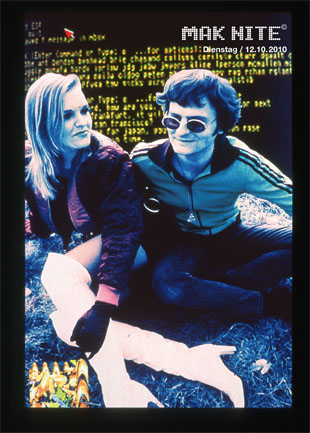
Peter Noever (preface), Howard Rheingold, Bruce Sterling, Gabriele Horn, Vitus H.Weh, Didi Neidhart, Peter Weibel, Dr.Hans Diebner, Christoph Tannert, David Hudson, Terence McKenna, Elisabeth Zimmermann, Doug Millison, Dr.Timothy Leary, Elisa Rose, STR, u. a.
Österreichisches Kulturforum Berlin, Stadt Frankfurt am Main – Dezernat für Kultur und Wissenschaft, BMUKK Wien, Hessisches Ministerium für Wissenschaft und Kunst, Kultur Land Oberösterreich.
Distributed in the United Kingdom
Cornerhouse Publications
70 Oxford Street, Manchester M1 5 NH, UK
phone +44-161-200 15 04, fax +44-161-200 15 04
Distributed outside Europe
D.A.P. Distributed Art Publishers, Inc.
155 Sixth Avenue, 2nd Floor, New York, NY 10013, USA
phone +1-212-627 19 99, fax +1-212-627 94 84
Between July 27th and August 29th, 2010, the eleventh edition of the FILE festival is taking place in Sao Paulo (Brazil), at several locations along the popular Paulista Avenue. After a decade of existence, this veteran festival, which spreads over several cities in Brazil (including Rio de Janeiro and Porto Alegre) as well as other international locations, has introduced for the first time its own award: the FILE PRIX LUX. With a total amount of approximately 120,000 euros, distributed in three categories, the prize is unprecedented in the continent and has received, on this first edition, 1,235 registrations from 44 countries.
Yet this award is not the only remarkable aspect of this year’s festival, which stands out for being particularly accessible to the general public. On the one hand, the exhibitions, performances and workshops as well as the symposium have no entrance fees, and therefore there have been many visitors, most of all young people who line up every day to experience the interactive installations at the FIESP-Ruth Cardoso Cultural Centre. On the other hand, the festival organizers, Ricardo Barreto and Paula Perissinotto, have developed this year a project that takes digital art to the Paulista Avenue by placing several interactive artworks at different locations in the public space. Finally, even the FILE PRIX LUX has been open to the interaction with the public by introducing a popular vote category and an online voting system which was accessible between May and June. This openness sets a good example of how media art festivals can engage the general public to approach this somewhat ignored form of art.
In general terms, the award categories at media art festivals have been subject to change as the creative uses of technology evolved during the last decades. The FILE PRIX LUX has the advantage of being created at a time in which it can be relatively safe to set up a few broad categories that cover most of the forms of combining art and technology. Only three categories have been established: Interactive Art (which usually refers to objects and installations that respond to inputs from the viewer/s), Digital Language (related to the festival’s title and which embraces any artwork that deals with language, narrative, code or text in a generative or interactive manner) and Electronic Sonority (the category assigned to any artwork in which the production or manipulation of sound is a key element). These three categories prove to be comprehensive, as shown by the diversity of the projects distinguished with a prize or an honorary mention: immersive interactive installations, musical performances, urban interventions, bioart pieces, a collectively created machinima movie and even an iPhone app are among this year’s FILE PRIX LUX awardees.
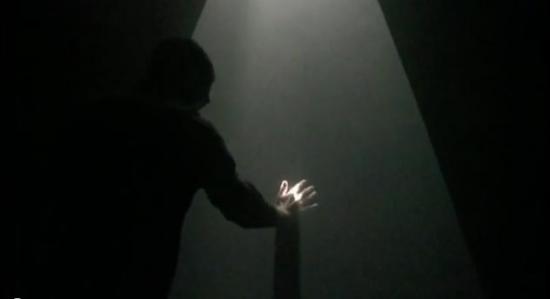
In the Interactive Art category, the winners are Ernesto Klar for Relational Lights (1st prize) and Kurt Henschläger for Zee (2nd prize). Both present immersive environments in which light and space are key elements, although the interaction is totally different. Klar’s work invites the viewer to interact with two projected geometric drawings inspired by the work of Lygia Clark. In a hazy dark room, the viewer sees two T-shaped projections of white light on the ground, which form a three-dimensional space which reacts to the visitor’s presence. The interaction is playful and really beautiful in its simplicity, whilst also limited in time: after a few minutes, the projections suddenly stop reacting to the user’s movements and reconfigure themselves in a new shape. This abrupt interruption is consciously introduced by the artist in order to remind the viewer that the artwork has a life of its own. In contrast, Henschläger’s Zee takes place mostly in the mind of an audience exposed to an overdose of audiovisual stimuli in a foggy room. Continuing the experience of his acclaimed performance FEED, this time the artist allows the viewer to walk around the space and have a more meditative sensory experience.
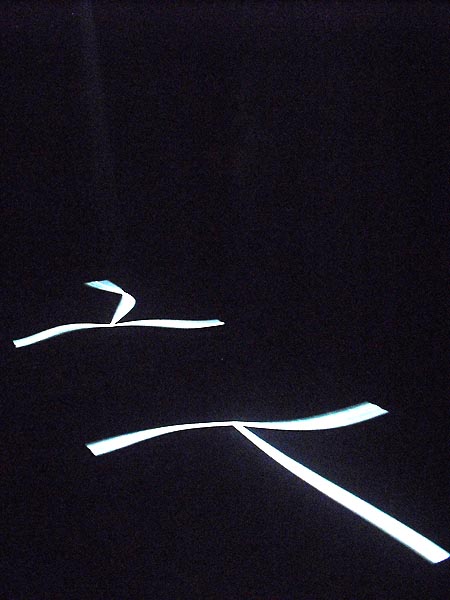
The Electronic Sonority category has brought together several outstanding works, among which Jaime E. Oliver’s Silent Percussion Project and TERMINALBEACH’s Heartchamber Orchestra have been distinguished with the 1st and 2nd prize, respectively. In both projects the human body is incorporated in a novel form in the creation of music, the sound being produced, moreover, not simply by direct inputs but by complex interactions in a constant flow of data. Oliver’s instruments convert the shapes created by the performer’s hands into streams of data that generate, in turn, different sounds. These sounds are not always the same, as could be the case in a traditional instrument, but are changed by the variables established in previous interactions. Thus, Oliver does not simply create a new form of interacting with an instrument but rather a new form of creating music. In a similar way, the [i]Heartchamber Orchestra[/i] project developed by TERMINALBEACH (Erich Berger and Peter Votava) explores a form of creating music based on a feedback loop in which the performers are writing and following the score at the same time. As the artists state, in their project “the music literally comes from the heart”: a network of 12 independent sensors record the heartbeats of the musicians in an orchestra and sends the data to a software that generates a musical score in real time. The musicians play the score as it is displayed on the laptops in front of them, while their heartbeats set the notes in a continuous cycle in which music and performer constantly influence each other.
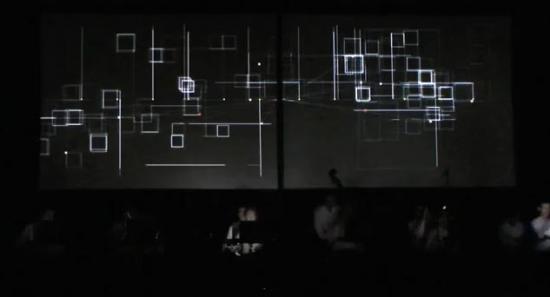
Digital Language is certainly the broadest category of this FILE PRIX LUX, its awardees being quite dissimilar in the formats they use and the objectives of their respective projects. The organizers define this category as including “all research and experiments in the ambit of the multiple disciplines that use digital media”, and the winners exemplify how diverse these disciplines can be. The 1st prize winner, Tardigotchi by the artists collective SWAMP (Douglas Easterly, Matt Kenyon and Tiago Rorke) is a bioart project that sets a critical comparison between artificial and real life. A nicely designed, steam punk-inspired device hosts, on the one hand, a tardigrade, a microorganism measuring half a millimeter in length, along with a robot arm that injects a substance that feeds the creature and a heating lamp that provides warmth. On the other hand, a digital display shows the virtual avatar of this tardigrade, with which the user can interact. Humorously referencing the popular Tamagotchi toy, the artists create a link between the avatar and the real creature: when the user presses the button to feed the avatar, the device inserts real food in the environment of the tardigrade; when an email is sent to the digital creature, a heating lamp gives warmth to the microorganism. Thus, interacting with the virtual pet has consequences in a real living being. This brings our attention into what we can consider alive and how we emotionally attach to artificial creatures while at the same time we undervalue the existence of other living beings. On a different approach, the 2nd prize winner, Hi! A Real Human Interface, by the collective Multitouch Barcelona (Dani Armengol, Roger Pujol, Xavier Vilar and Pol Pla), proposes a more human relationship with technology. A video presents the concept developed by this interaction design group of a different GUI in which a real person is displayed as impersonating the computer. Common interface elements are replaced by handmade physical objects which remind the aesthetics of a video by Michel Gondry. The result is a playful form of interaction in which simple operations such as checking email or upgrading the operating system are shown as actions carried on with real objects by a person inside a box. The proposal is engaging and certainly sets a departure from the old desktop concept, yet it remains unsure to what extend this type of interaction can be applied in a real operating system.
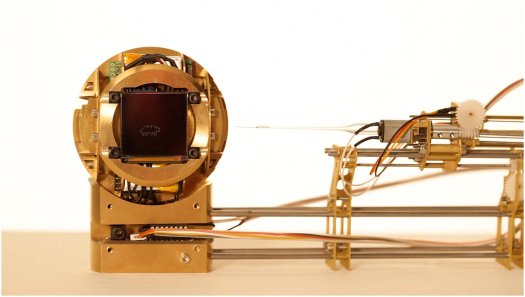
The works that obtained a Vesper statuette (symbol of the FILE PRIX LUX award) along with the also outstanding Honorary Mentions are exhibited at the FIESP-Ruth Cardoso Cultural Centre in a group show that also includes FILE Media Art, a selection of more than 70 works that can be accessed on several computers, as well as a selection of videogames and machinima films. The exhibition is thus richer in content than it would seem at first sight, as the space is divided in numerous sections that conceal several installations which demand (as usual) almost total obscurity. The artworks are well presented, although at times the sound from one installation invades the others, and there are no wall labels that inform the viewer about the concept of the piece or the way to interact with it. The latter, much-discussed issue is quite important, since the info-trainers cannot explain the artworks to every visitor, and quite often this entails that some people may not interact with the pieces or worse, start smashing buttons or interfering projections blindly in the hope of modifying them. Despite this fact, the exhibition has proven to be very successful during the first week of the festival, with a steady flow of visitors who showed a profound interest in the artworks.

A part of the exhibition is devoted to the FILE MACHINIMA section, curated by Fernanda Alburquerque, who selected over 40 works. Among these is the award winner in the Popular Vote category, War of Internet Addiction, by Corndog and the Oil Tiger Machinima Team from China, a 64-minute movie collectively created by players in the MMORPG War of Warcraft. More than mere entertainment, this film has been created as a form of protest against the Chinese authorities’ attempt to control the access and commercial benefits derived from the WoW game, which is extremely popular in the country. The film has had 10 million views since January 2010 and despite being available only in Chinese, it has been the favorite work of those who participated in the online voting system of the FILE PRIX LUX. Besides this feature film, other short films explore the possibilities of building narratives in virtual environments such as Second Life and videogames such as Half Life 2, Eve Online or Shadow of the Colossus.
In addition to the main exhibition, the FIESP Cultural Centre hosts a series of performances and screenings. Under the title Hypersonica, the festival presented a series of digital music performances, among which where the two winners of the FILE PRIX LUX in the Electronic Sonority category. FILE DOCUMENTA, curated by Eric Marke, offers in its 5th edition a selection of “rare and new” documentary films, among which Andreas Johnsen’s Good Copy Bad Copy, an interesting exploration of the conflicts between remix artists and copyright owners, or Robert Baca’s Welcome to Macintosh, which records the first years of the history of Apple Computers.
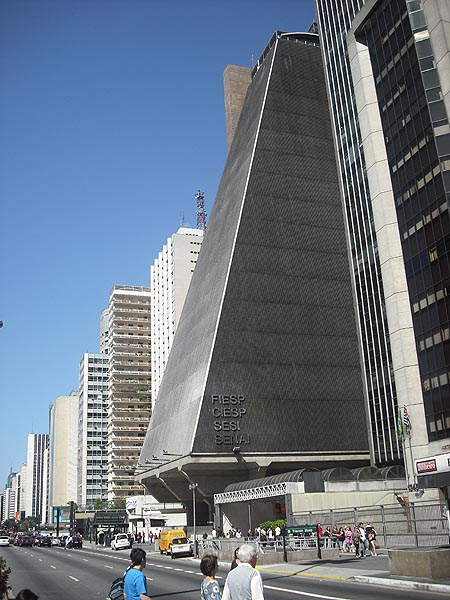
The symposium, hosted by the Instituto Cervantes in Sao Paulo, gathered several experts and artists who presented their explorations in the theory and practice of media art. Among the most interesting contributions were the presentation of Prof. Espen Aarseth on the aesthetics of ludo-narrative software, and the colloquy of South American digital art, in which Raquel Renno (Brazil), Jorge Hernandez, Ricardo Vega (Chile) and Vicky Messi (Argentina) discussed the current developments in the media art scene in the South Cone.
Alongside the FILE PRIX LUX, the most outstanding feature of the present edition of the festival is FILE PAI (Paulista Avenida Interactiva), which takes several interactive artworks to the public spaces in the Paulista Avenue. Interactive art offers the possibility of bringing art to the public space in a more efficient and dynamic form than what is usually known as “public art”. As Ricardo Barreto states: “the public environment is not something empty, aseptic and dead, as is the old white cube; on the contrary, it is an environment teeming with life, with multiple interests and multiple behaviors”. Interactive art integrates itself into this environment and is much more apt to relate to a public that is now willing to take an active role. The organizers of the FILE festival have distributed twelve interactive artworks along the Paulista Avenue, at subway stations, inside shopping malls, and even in a bus. The selected artworks include, among others, videogames such as Patrick Smith’s Windosill or the celebrated games of That Game Company, Flower and Flow; VR/Urban’s SMSlingshot, an urban intervention project that allows users to write a message in a custom-made slingshot that incorporates a screen and a keyboard and then send the message to a wall, where it is displayed as a virtual graffiti; Karolina Sobecka’s Sniff, an interactive projection in which a virtual dog reacts to the presence of passersby; the installations of Rejane Cantoni and Leonardo Crescenti Piso and Infinito ao Cubo, which attracted a large number of people, and the sound piece Omnibusonia Paulista by Vanderlei Lucentini, which is played in a bus as it moves along the avenue, interacting with several points in the itinerary and thus generating a new set of sounds in every trip. These works reveal the possibilities of integrating interactive art in the public space, to the point that, as Ricardo Barreto indicates, “the new paradigm of public art will be the interactive city”. The busy Paulista Avenue is certainly a good location for the creation of an emerging, interactive city.
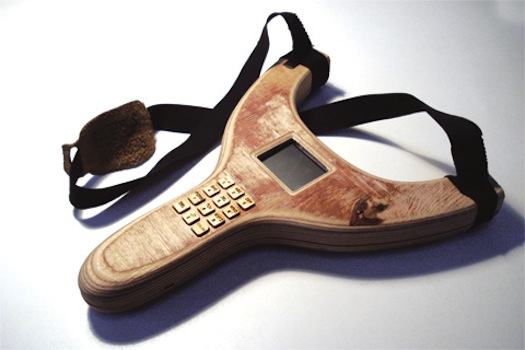
In this 11th edition, the FILE festival has achieved a state of maturity. The FILE PRIX LUX, FILE PAI and an estimated 25,000 visitors to date support its claim of being the largest festival of its kind in Latin America, and a steady event that places Brazil in the map of the international digital art scene. In a tightly interconnected world, each region is a node: there isn’t a center and a periphery anymore, there are no colonies. FILE exemplifies how a region can become a powerful node in this network by promoting the most recent developments in art and technology, avoiding obsolete distinctions between North and South and becoming a point of development for the future stages of our digital culture.
Patrick Lichty, renowned conceptually-based artist, writer, curator and activist. He has exhibited internationally since 1990. Featured image: taken by Anne Helmond.
Introduction.
Patrick Lichty is an individual who seems to be like a non-stop engine. A hungry human being, engulfed in a prolific journey of constant exploration, whether it be making artworks, writing, activism, curating, collaborating, researching or teaching; he’s deeply involved and engaged in media arts culture. Since 1990, he has pursued art and writing that explores how we relate to one another through technology and how we relate to it. This includes art, media, and computer technology. “Media are one of the “glues” of civilization, and this glue is as fundamental in representing all aspects of society, culture, and interpersonal relations. I explore this through critical theory, conceptual New Media art, and performance/social intervention.”
Lichty also works in almost all forms of Digital 3D – Animation, VR, Fabrication, Physical Computing. Translating the work for display through video, animation, live installation, electronics, virtual reality, physical computing, robotics, digital fabrication and imaging. As well as realising virtual works into traditional forms such as plates for print, paintings, expanding the focus of his work in a broader context.
Lichty’s work, concepts and practice do not rest in one place, it crosses over into many areas of creative production. By getting his hands dirty with the medium of technology, with its relational aspects. The spirit of the work goes beyond singular catch phrases and one-liners, adding complexity and value which only media art and its ever widening scope can demonstrate.
It’s big art with big ideas, interwoven with micro levels of human emotion, asking questions about life and more. This two part interview aims to clarify some questions I have been wanting to ask Patrick Lichty for a while now, so hang on and lets see what happens…
Start of Interview:
Marc Garrett: You have been deeply engaged in the creation of net art, networked art, media art and related activities at various levels, whether it has involved you making it, writing about or curating it. What inspired you to choose which is, now unquestionably, one of the most contemporary and expansive forms of creativity, in the first place?
Patrick Lichty: This is a question that has come up repeatedly. “Why did you choose (what is now called) New Media, or the intersection between society, technology, and culture?” It is really a matter of examining my native culture, which has been that of technological culture. I was raised by an artist who gave me my first electronics set at the age of 8, and my first computer by the age of 17, while raising me on a steady diet of science fiction. I was a child of McLuhan; growing up in the electric networks on a diet of very hot media. However, I do also paint, and when I think it’s appropriate, I also do use traditional media. In short, I speak this culture because it’s my native language.
MG: To kick off this interview I thought it would serve our readers well to discuss your work from a perspective of themes. Over the years, exploration through your practice has crossed over into many different disciplines and fields. So lets begin with Psychogeography. To those who are unfamiliar with this practice, the most well defined and serious use of it was in 1955 by Guy Debord: “a whole toy box full of playful, inventive strategies for exploring cities … just about anything that takes pedestrians off their predictable paths and jolts them into a new awareness of the urban landscape.”
“Of all the affairs we participate in, with or without interest, the groping quest for a new way of life is the only thing that remains really exciting. Aesthetic and other disciplines have proved glaringly inadequate in this regard and merit the greatest indifference. We should therefore delineate some provisional terrains of observation, including the observation of certain processes of chance and predictability in the streets.” Introduction to a Critique of Urban Geography. Guy Debord
Patrick, one of your projects which springs to mind, is a work called SPRAWL “…an exploration of the suburban American landscape, examining the macrocosmic issues related to suburban expansion by considering the microcosmic issues of the experiences of a bellwether area of the US: Stark County, Ohio. In navigating the landscape you will view over thirty panoramic photographs of sites that are now forever changed by the area’s development as well as interviews on video and historical documents which create a map of the larger social landscape of the surrounding community.”
A complex and involved project. What inspired you to examine the ‘suburban American landscape’ in such a way, and how long did it take to complete?
PL: In talking about Debord’s definition, I’d like to talk about my own interpretation of the idea of Psychogeography. If you consider the word etymologically in contrast with Debord’s meaning, you can say that it should not be limited to the urban landscape, but the relationship of human interaction with any landscape. From this, we move out of the city to any relation between community and space, which is my interest, and I like to term as a practice of ‘land use interpretation’ to borrow Matt Coolidge’s (CLUI) term. All of my work in this range, from SPRAWL to the three projects in varying stages of completion (the Hulett Project, Ghosts of Adak, and SPRAWL 2011) come from a personal observation that expands to a macroscopic discourse through the larger exploration/research of the space.
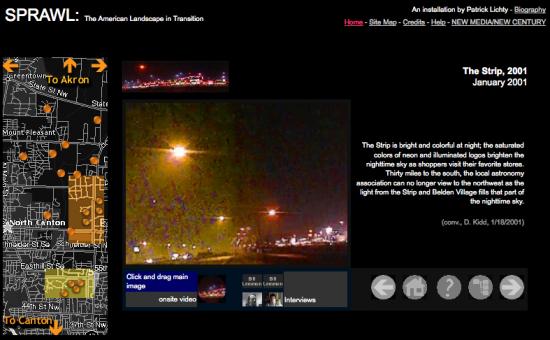
SPRAWL began as a 3-year personal investigation of my own distress about suburban sprawl in the late 1990’s near my home town, and linking this to the larger national conversation regarding sprawl at the time. For reference, I was born in nearby Akron, Ohio – the subject of Chrissie Hynde and The Pretenders song My City Was Gone, which describes the colonization of an industrial city and its countryside by sprawl and shopping malls, so if SPRAWL has a soundtrack, that would be it. I began SPRAWL in 1998, as a series of panoramic photographs of various sites near my home, with just a vague impression that they were a cohesive body of work. Also, the idea of nostalgia for the pastoral farmland of my younger days seemed far too simple to be satisfying, so I knew there was something to it. So, when the Smithsonian American Art Museum put out a call for works dealing with landscape online, I felt this was a fantastic place to really explore this idea in a larger context. Then they offered me the commission, the project went from a set of 32 panoramas to a hyperdocumentary in about three solid months of production, including travelling back to Ohio from Louisiana, interviewing, doing on-site footage, and performing historical research.
What I think is important about SPRAWL is that it’s ‘sensable research’, in that it managed to manifest the ideas I had about this problem, learning a lot more about community ecology, allowing the articulation of a microcosmic issue in macroscopic terms. In more personal terms, it allowed the development of my question of social issues related to my concern with the understanding that my perspective was only one of many, and from examining a multitude of perspectives, I could learn what the larger issues were, and create a discourse with a larger community.
MG: On your website, for the Ghosts of Adak there is a statement of yours, saying “My father and I have something in common. He was born in 1921 and spent 2-1/2 years in the North Pacific campaign on Adak Island in the Western Aleutian Islands in Alaska. I have heard about it since 1962. So I went there for 10 days. And I found him all over again.”
I also visited another site to find out about the community living there, and on this site called Alaska Tracks. Ned Rozell writes “Adak’s having a tough time, and the community of about 200 people in the mid-Aleutians has been struggling since the Navy pulled about 6,000 people out in 1997. It’s got a feel to it now like the Love Canal area of Niagra Falls had in the 1980’s, like everyone took off and left a few ghosts behind.”
How was your 10 days stay there and what did you learn?
Do you have a clear idea of what this project will become? Also, I noticed that it is part of an artist residency program at Eyebeam R&D Atelier NYC. How do you intend to present this work, in a space, on-line or something else?
PL: That’s a book in itself, and probably will be, which is part of your next question. First, why – My father is nearing 90, and for most of my life, he had gone on about this “place” that he had been for a period of time, and recounting endless stories about it. No place else had that sort of impact on him. Does not talk about Seattle, or San Francisco, or even Chicago (all places he had spent time) like that. I also think that as he is nearing 90, and in that he and I have a very strong bond (actually both Lodge brothers, if you can believe that), and I wanted to know about him in the deepest way possible, and probably in so doing, learn about myself and the site. But then, that fits the process.
The issue with Adak is that it is a tremendously complex place even before I overlay my own emotional architectonic. It was the site of the Northern Pacific campaign of the United States versus Japan during the Second World War, mainly as a diversion from Midway. I had made a deal with the CEO of the facility to exchange the photos for a room, a 40-something Niigata-born guy with petrochemical ties, whose father might have been my father’s enemy, and ideologically, probably was mine, but the personal nature of the trip put that on hold. There were a lot of external and internal conflicts that I had to navigate just to get there.
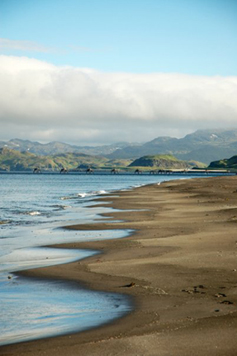
In short, Adak is currently the remains of the Adak Naval Base and surrounding facilities, which is basically a minor port, petrochemical storage facility, a fishery, and home of the westernmost airport linked to the Continental US, further west than Hawaii. If you rent a car, you rent one of the trucks a local offers, the gas comes from the tank farm, and the ‘hotel’ is a number of duplexes that the residents rent out to visitors. There is a General Store, a cafe at lunchtime, and the old VFW becomes the tavern for dinner, offering an entree or some microwaveable snacks along with a full bar. You sign a disclaimer to absolve the Corporation of any liability if you encounter black mold, fall into an old stairwell, sinkhole, run into an old unexploded shell, etc. I’m speaking a little darkly about this place, but it’s pretty rugged with radically changing weather, frequent earthquakes, and they’re still cleaning up the old artillery ranges.
On the other hand, it’s one of the most amazing places to be. It’s right at the edge of civilization, a volcanic arctic island withn no trees and some of the most amazing wildlife you’ve ever seen – eagles, otters, seals, birds. I can see why my father talked about it so much.
One other thing of note is that while doing the project, I’ve run into all sorts of people who have served, lived, or even been born there, as there was a 6,000-person family facility. On the plane from Minneapolis to Anchorage, I ran into an airline pilot who had just been on a caribou hunt there, and he gave me his GPS information and a lot of pictures. On another trip, I ran into a woman who was born there. It was unbelievable.
What did I learn? I learned about a history that few remember, I learned about my own history and how it affects me. I also learned about the local culture, its history, how Alaskan culture meshes with corporate interests to create a lot of the issues seen in mass media. There isn’t a lot of concern for the area from the locals, and actually the Military was doing a decent job with the cleanup. From a more personal level, I also came to understand that everything is transitory. Art, culture, society, all ephemeral in terms of a mountain. Human beings don’t matter very much to a volcano, but definitely the other way around.
When I was walking on the western (uninhabited) side of the island, I had napped on some tundra and realized I didn’t have my GPS or keys – all my keys. I knew where I slept, and I leave my keys in the car a lot. The worst that could happen was that I would have to walk 5 miles into town in a cold drizzle, get Jimbo the Constable to let me into my car and get the truck in the morning. In the end, I learned that if it isn’t a landmine, it’s not that big of a deal.
“Do you have a clear idea of what this project will become? Also, I noticed that it is part of an artist residency program at Eyebeam R&D Atelier NYC. How do you intend to present this work, in a space, on-line or something else?” This is really tough for me – no, I don’t have a clear idea yet because it’s so hard to frame. It probably needs to be a book, but it isn’t going to be done for a couple more years. I’d like it to be a hyperdocumentary like SPRAWL, but not in the same way. Also, I think it would make a great presentation, and the images are really beautiful. As I mention, it’s terribly hard to frame this project, and I think it should be allowed to be large.
MG: Let’s talk about a piece you created with The Yes Men. As many in the know, know – and of course those who have fallen foul to the Yes Men’s activist-pranks; they are legendary cultural saboteurs. They have impersonated World Trade Organization corporate spokespersons, including Dow Chemical Corporation, Bush administration spokesmen on TV, at various business conferences around the world. In order to demonstrate some of the mechanisms that keep bad people and ideas in power. Focusing attention on the dangers of economic policies that place the rights of capital before the needs of people and the environment. They have more recently become more known to a world-wide audience for The Yes Men, a movie.
Could you inform myself, and readers about the mock industrial video ReBurger and how it came about?
PL: Right. The animation work for The Yes Men is a strange beast, because it came from previous work for a group called RTMark, from which some of us came from to do Yes Men, which is well documented in the two movies. Again, the process for these animations, which I later edit into industrial videos is also an odd one. Usually, when there is an intervention (and I have sometimes appeared in person), Mike will give me a call and say something like, “Hey Patrick, we have this idea for this, for that company…” In this case, it was an idea for recycling feces for the Third World, and not much beyond that general concept. At first, I was thinking of translating dietary fiber to textile manufacture, creating a suit that would look like S**t, but shortly thereafter, brainstorming created the McDonald’s parody. I knew it was going to be shown at Plattburgh College, but beyond that, I didn’t have much context. So, that’s where my process in context with the larger presentation sort of diverges. Mike, Andy and Matt were developing the presentation, and I started in on the simple metaphor of eating shit. In short, I get some basic ideas together, and then produce the clips (not the full industrial video).
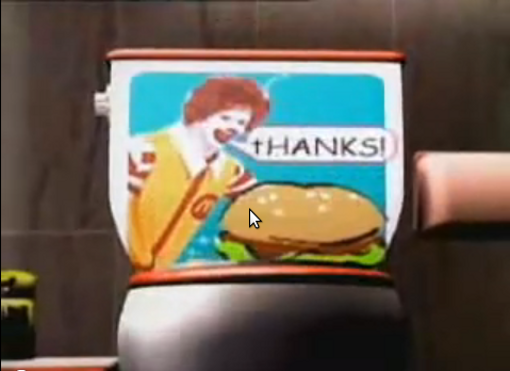
Beyond that basic joke, it’s really just exaggeration – the idea of an international infrastrucure for the collection of post-consumer waste, the branded toilet, and the special product names, like “McDung”. The scene that seems to get people is the one of the Ronald McDonald Colostomy Machine (the paste dispenser) as it creates the brown coil of reprocessed waste and then presses it into nice patties. For me, this is the use of pure literal metaphor, and maybe that’s why it works. Maybe it’s because it stands for a corporation that offers “choices” for healthy eating that few choose, and McDonalds willingly contributes to the obesity and illness of billions. In my opinion, ReBurger just tells the truth.
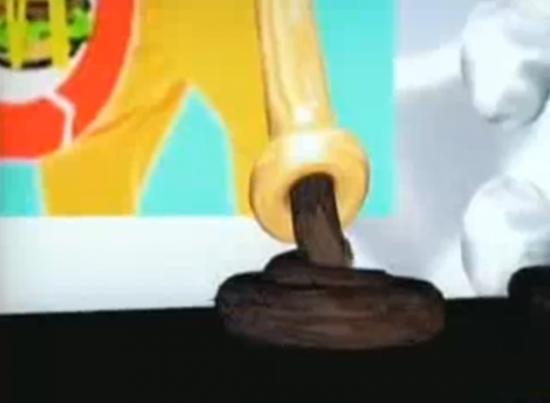
But the reason why people like the video is also a reason why it was a real problem for the sale of the movie at Sundance 2003. Although it was obvious fair use, many in the film industry were also buyers looking at the movie. Mike Bomnano told me that the legal departments of the movie companies were trying to determine the degree of risk of satiring McDonald’s, complete with branding. This was obviously Fair Use under US Copyright, but again, the possibility of an egregious law suit could have happened. In the end, McDonalds decided to ignore the piece, which was great, since I believe it’s one of the stronger Yes Men pieces.
MG: In the UK, June 1997, the infamous McLibel Trial (mcspotlight.org) came to an end. The case was between McDonald’s and a former postman and a gardener from London, Helen Steel and Dave Morris. It ran for two and a half years and became the longest ever English trial. “…Helen and Dave decided that they would stand up to the burger giants in court. They knew each other well from their involvement in community based campaigns in their local North London neighbourhood and felt that although the odds were stacked against them, people would rally round to ensure that McDonald’s wouldn’t succeed in silencing their critics.” The defendants were denied legal aid and their right to a jury, so the whole trial was heard by a single Judge, Mr Justice Bell.
“The verdict was devastating for McDonald’s. The judge ruled that they ‘exploit children’ with their advertising, produce ‘misleading’ advertising, are ‘culpably responsible’ for cruelty to animals, are ‘antipathetic’ to unionisation and pay their workers low wages. But Helen and Dave failed to prove all the points and so the Judge ruled that they HAD libelled McDonald’s and should pay 60,000 pounds damages. They refused and McDonald’s knew better than to pursue it.” Mcspotlight.
I can imagine that McDonald’s were considering their past experience, with cases such as the McLibel Trial. “The legal controversy continued. The McLibel 2 took the British Government to the European Court of Human Rights to defend the public’s right to criticise multinationals, claiming UK libel laws are oppressive and unfair that they were denied a fair trial. The court ruled in favour of Helen and Dave: the case had breached their rights to freedom of expression and a fair trial.”
For your project 8 Bits or Less, in 2002, you wrote a brief statement which I am assuming must be about your own condition, saying “An artist who has become blind (whether physically or ideologically) has resorted to viewing his world through the prosthetic devices that constitute his sense, like cell phones, and wristcams. The result is a distorted landscape that considers Situationist theory, surveillance culture, identity, and alien abduction.” Can I begin by asking why this statement came about and then what part of the project you feel communicates or is expressesed most successfully?
PL: First on the matter of ReBurger, I think that the smarter entities know not to react, but that isn’t always the case. Perhaps the ones who have been burned, now have a smarter PR team.

8 Bits or Less is a series I did that was influenced by several things. For many years, I had felt that as technological artists we are slaves to “innovation”, which is merely an exciting word to stand in for the commercial upgrade path in software and hardware. This set of videos addresses my dissatisfaction with the notion of verisimilitude in regard to techological art, or the “big ticket” piece. Ever since the late 1990’s my response has been to either get by with just enough aesthetic polish to make the work believable/legible, or to willingly embrace a low rez/grayscale time. The lo-fi grayscale is not the same as 8-Bit, which has 256 colors and refers to early personal computing and video games. Perhaps it is closer to my passion for Slow Scan television (a 1970’s video modem technology in which a frame is transmited every 7 seconds) or my position of eschewing resolution and color depth as a form of intransigent aesthetics. In addition, the fact that the frame rate is at most 3 frames per second, and was shot with a Casio Wristcam at one frame every 1.5 seconds was also my homage to Muybridge, mainly in terms of the grayscale and serial qualities of the video. Beyond that, and the fact that each video consists of about 900 frames, all hand edited, perhaps 8 Bits or less is more about my politics about the technological industry and personal differences with New Media and technolust.
On the personal side, 8 Bits or Less is an allusive fable having to do with the fact that I have been blind a couple times in my life, but this blindness can translate to the fact that for a period of time I felt that I had immersed myself in my studio for long enough, that I saw the world primarily from my screen. Therefore, although I had been visually imparied for part of my life, much of which has been fixed by having cataract removal in 1999, I still felt that there was a metaphorical blindness caused by society’s use of mobile devices, the existential distorions of 24-hour cable networks and the Internet. Therefore, the series (if you listen very closely) incorporates a mix of postmodern theory and hyperbolic statements about aliens, obscure jokes about bits and nybbles, surveillance culture and the abjection of low fidelity.
What I think is successful about it is that it holds together at all, or that it engages the viewer without necessarily relying on leading edge technological conceits, but perhaps using the wristcam aethetic is a conceit in itself. Antoher aspect that I have enjoyed about it after five or six years is that it is a really hallucinogenic series of pieces. But then, I think this is the point that Gibson made about cyberspace that has been expanded on by the Baudrillardian mediascape and the Internet – the consensual mass hallucination (facilitated by mass communications).
———
Watch 8 Bits or Less series. Images link to videos online.
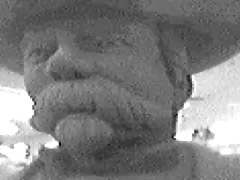
A wristful of bits. Found on DVlog.
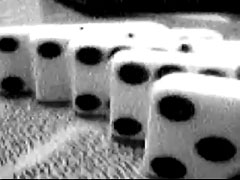
8 bits or less. Found on DVlog.
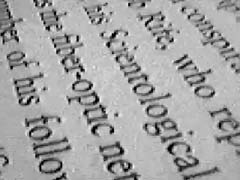
http://www.dvblog.org/movies/04_2007/lichty8bit/closevision.mov
Close vision. Found on DVlog.
Big thanks to DVblog for 8 Bits or Less images & video links.
http://dvblog.org/
Mark Napier’s Venus 2.0
Angela Ferraiolo
February 5, 2010
“Now that I’m done’ I find the artwork disturbing. It freaks me out. Maybe I’ll do landscapes for a while to detox.” — Mark Napier
Artist Mark Napier, well-known for the net classics Shredder, Riot, and Digital Landfill, recently exhibited his latest work Venus 2.0 at the DAM Gallery in Berlin. A sort of portrait via data collection Venus 2.0 uses a software program to cross the web and collect various images of the American television star Pamela Anderson. These images are then broken up, sorted by body parts put back together and — as this inventory of fragments cycles onscreen, a leg, a leg another leg — the progressive offset of each rendering of Anderson’s head, arms, and torso makes her reconstructed figure twist, turn and jerk like a puppet. It’s odd looking. Even her creator is a little afraid of her:
“I have to say’ if I ever meet Pamela Anderson in real life I think I’ll completely freak out and run away. I don’t think I could have a conversation with the woman after this project … I started with a sympathetic view of the actual Pamela Anderson. She is part of the spectacle of sexuality in contemporary media. She’s caught in that ‘desiring machine’ as much as any other human’ probably even more so. She has surgically modified her body in order to have greater leverage in the media. Does this put her in control? I think not.”
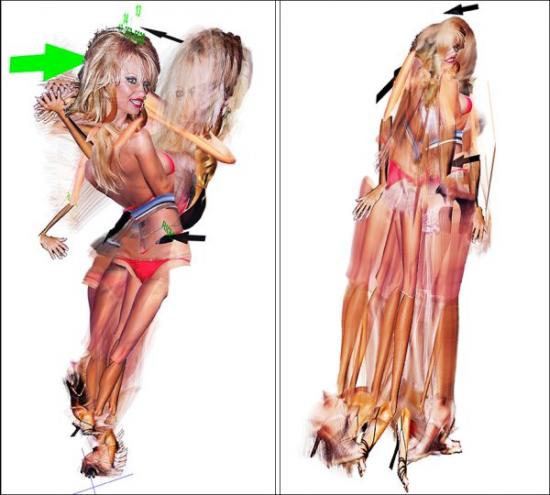
Napier’s project doesn’t answer or intend to answer the question of who is in control either, but it plays with the possibilities. Although I wasn’t able to see the portrait at its exhibition. I did track down part of the series Pam Standing at a private location here in New York. Napier has also posted video excerpts of the work online. Unfortunately, these still images and clips are a bit too static to really do the piece justice. If you get to see the real thing and if you look for a while, you’ll see what I mean. Venus 2.0 is an amazing jigsaw puzzle, a deceptive surface of shifting layers – part painting and part search result.
The effect is translucent, lyrical, mathematic and creepy. When I implied that it must have taken an awful lot of precision and calculation to get something like this to come together, Napier insisted that focusing on the technology behind Venus 2.0, its algorithm, or even on the unique materiality of networked art in general, is a way of missing the point. The way he relates to Venus 2.0 is through the painter’s hand. What counts is not the data feed, but who were are, what we want and how we behave:
“The artwork is a riff on sexuality as an elaborate hoax played by a precocious molecule that builds insanely complex sculptures out of protein, aka, meat puppets or more simply, ‘us’. These animate shells follow a script that’s written and refined over the past half billion years. And that script is in a nutshell: 1) survive 2) reproduce 3) goto #1. So sexual attraction is the carrot to DNA’s stick. Attraction is part of the machine. In art history this appears as the tradition of Venus. And more recently: Duchamp’s ‘Bride’. Magritte’s ‘Assasin’. Warhol’s ‘Marilyn’. The focus of digital art is still the human being. Don’t be distracted by the gadgets.”
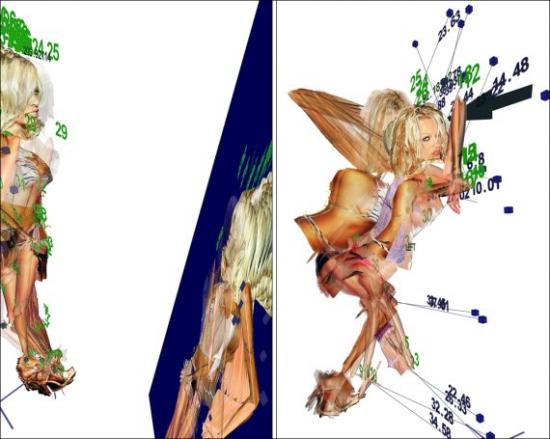
Hi-tech or not, new media artists are by now well-practiced in the technique of unraveling a familiar image to expose an occluded, yet equally valid identity. In Distorted Barbie, Napier relied on a repeated process of digital degradation to blur both the literal and conceptual fiction of the Mattel franchise. Another early project stolen, took the female body apart, presenting attraction as database. Years later these kind of approaches, pixel manipulations and indexing without comment, as well as parsing and remixing have become a sort of standard operating procedure in new media. So much so that as technique becomes more well-known and more accessible, it can be hard to tell one work from another or one artist from the next. With this in mind’ it seems important to note that in the case of Venus 2.0 it is not so much a choice of subject or an organizational scheme that guarantees the final effect, but the manner in which Napier investigates the image and the ways in which Napier illustrates and manipulates both the visual elements of portraiture and his relationship to the figure involved.
Napier builds and destructs, assembles and tears apart, but in doing so tries his best to keep us focused on these activities as processes. At times Pam’s contortions are allowed to expose the wireframe which allegedly guides her construction and at certain key points on the interface, there is also a steady stream of vector coordinates to embody the idea of data. But Napier makes less of technology than another artist might by effacing what some would tend to elaborate on, in order to draw our attention elsewhere – usually towards evolution, gradation and the ways in which images evolve, and by extension the ideas that inspire those images which reflect how unstable elements are, even treacherous:
“I work at probabilities: what is the likelihood that the figure will be totally opaque? How often does it get murky and undefined? How often should I let that happen and for how long? How often does the figure jump? How long till the figure lands and stands up again? How much time is spent in chaotic motion and how much in stillness? How often does something completely messy happen? Like the figure gets tangled up in a ball that has no structure. I don’t know how the piece will play out each minute, but I know what kind of situations will arise in the piece. I can plan those likelihood, and then let the piece play and see what it does.”
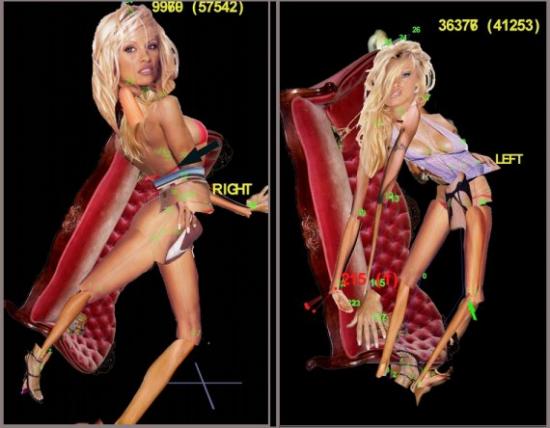
So, like the woman who inspired her. Pam Standing is beautiful, but more unsettling. What makes Pamela Anderson the most frequently mentioned woman on the Internet? Why do we mention her? What is it we want when we give our gaze to celebrity? What has celebrity done to attract us? Whatever your answers, what Napier privileges in his response is not a fixed portrait of a star, but a cloud of iteration that produces its own image and reproduces that image, jangled, confused and full of surprises. A portrait whose finest moments are accidental and whose design is an accumulation of fragments that tense and dissolve, floating like clouds one instant and then sinking like lead the next. This is where the imagination takes a step forward and Napier the artist or Napier the geek becomes Napier the puppetmaster, a networked Dr. Coppelious:
“My favorite moment with the PAM series was when I finally got all the math to work so that the body part images displayed correctly and the correct side of the body showed at the right time and the stick figure suddenly started to look like a ‘real’ puppet that was starting to come alive in the golem-esque way that I thought it could when I was sketching out the idea. I had that Dr. Frankenstein moment: ‘She’s aliiiiiiiiiive!!!!!!!!!!!!!’ which was really the point all along, to create this virtual golem that is clearly not alive at all and yet teases us all with this false appearance of life. Venus 2.0.”
Until the layers of arms, legs, breasts and hips collapse in on themselves and Pam is back where she started, a manipulated beauty unable to escape presentation as a collaged monstrosity.
Note: Mark Napier has been creating network art since 1995. One of the earliest artists to deal thematically and formally with the Internet, Napier has been commissioned to create net art by the Solomon R. Guggenheim Museum and the San Francisco Museum of Modern Art. His work has appeared at the Centre Pompidou in Paris’ P.S.1 New York’ the Walker Art Center in Minneapolis’ Ars Electronica in Linz’ The Kitchen’ Kunstlerhaus Vienna’ ZKM Karlsruhe’ Transmediale’ iMAL Brussels’ Eyebeam’ the Princeton Art Museum’ la Villette’ Paris’ and at the DAM Gallery in Berlin.
Featured image: Two web cam installations by Ivan Pope – Lost Magic Kingdoms and Tabletop
Web Cam Theatre – two web cam installations, Lost Magic Kingdoms and Tabletop by Ivan Pope
Objects are cast in a performative context displaying motion and time using Internet technology. By using very basic equipment, cheap web cams, cheap software, cheap objects Ivan has created a twilight world. We witness a psychogeographically influenced environment that engages a fluent mix of conceptual and poetic crossovers with performance/live action. The installation is minimal, with light settings, the quality of the image and time based changes largely uncontrollable.
When you click onto the page of ‘Lost Magic Kingdoms’, images slowly cascade before your eyes down the browser page. You discover its history, with different times and moments of the day recored by two cameras on either side of a small table, enclosed by a screen. The cameras take it in turn to transmit the scene. Inspired by an installation made in 1987 by Eduardo Paolozzi, called Lost Magic Kingdoms and Six Paper Moons, revealing how art could be constructed by rearranging existing objects. With ‘Tabletop’, a single camera is mounted on a tripod. The lights go on and off. The camera pans the tabletop, looking for action and a new world is created.
These two web cam installations will be live until September 20 2003. The format will remain the same, but the objects and arrangement will vary. The rate of image change will also vary.
Both works show the relational nature of objects, a kind of magical realism falls into place like an Angela Carter’s ‘Nights at the Circus (1984), half human and half mythical; between actuality, the physical and the virtual, reality and non-reality. Changing every six minutes, you know that something is going to happen but the timeline is relative to your own modem, your own situation, and your own desires.